Lunar Gateway
Initiatives and Programs
Lunar Gateway of NASA's Artemis Program
As reflected in NASA's Exploration Campaign, the next step in human spaceflight is the establishment of U.S. preeminence in cislunar space through the operations and the deployment of a U.S.-led Lunar Orbital Platform-Gateway. Together with the Space Launch System (SLS) and Orion, the gateway is central to advancing and sustaining human space exploration goals, and is the unifying single stepping off point in our architecture for human cislunar operations, lunar surface access and missions to Mars. The gateway is necessary to achieving the ambitious exploration campaign goals set forth by Space Policy Directive 1. Through partnerships both domestic and international, NASA will bring innovation and new approaches to the advancement of these U.S. human spaceflight goals. 1) 2)
As NASA sets its sights on returning to the Moon, and preparing for Mars, the agency is developing new opportunities in lunar orbit to provide the foundation for human exploration deeper into the solar system. For months, the agency has been studying an orbital outpost concept in the vicinity of the Moon with U.S. industry and the International Space Station partners. As part of the fiscal year 2019 budget proposal, NASA is planning to build the Lunar Orbital Platform-Gateway in the 2020s.
The platform will consist of at least a power and propulsion element and habitation, logistics and airlock capabilities. While specific technical and mission capabilities as well as partnership opportunities are under consideration, NASA plans to launch elements of the gateway on the agency's Space Launch System or commercial rockets for assembly in space.
"The Lunar Orbital Platform-Gateway (formerly known as the Deep Space Gateway) will give us a strategic presence in cislunar space. It will drive our activity with commercial and international partners and help us explore the Moon and its resources," said William Gerstenmaier, associate administrator, Human Exploration and Operations Mission Directorate, at NASA Headquarters in Washington. "We will ultimately translate that experience toward human missions to Mars."
The power and propulsion element will be the initial component of the gateway, and is targeted to launch in 2022. Using advanced high-power solar electric propulsion, the element will maintain the gateway's position and can move the gateway between lunar orbits over its lifetime to maximize science and exploration operations. As part of the agency's public-private partnership work under Next Space Technologies for Exploration Partnerships, or NextSTEP, five companies are completing four-month studies on affordable ways to develop the power and propulsion element. NASA will leverage capabilities and plans of commercial satellite companies to build the next generation of all electric spacecraft.
The power and propulsion element will also provide high-rate and reliable communications for the gateway including space-to-Earth and space-to-lunar uplinks and downlinks, spacecraft-to-spacecraft crosslinks, and support for spacewalk communications. Finally, it also can accommodate an optical communications demonstration – using lasers to transfer large data packages at faster rates than traditional radio frequency systems.
Habitation capabilities launching in 2024 will further enhance our abilities for science, exploration, and partner (commercial and international) use. The gateway's habitation capabilities will be informed by NextSTEP partnerships, and also by studies with the International Space Station partners. With this capability, crew aboard the gateway could live and work in deep space for up to 30 to 60 days at a time.
Crew will also participate in a variety of deep space exploration and commercial activities in the vicinity of the Moon, including possible missions to the lunar surface. NASA also wants to leverage the gateway for scientific investigations near and on the Moon. The agency recently completed a call for abstracts from the global science community, and is hosting a workshop in late February to discuss the unique scientific research the gateway could enable. NASA anticipates the gateway will also support the technology maturation and development of operating concepts needed for missions beyond the Earth and Moon system.
Adding an airlock to the gateway in the future will enable crew to conduct spacewalks, enable science activities and accommodate docking of future elements. NASA is also planning to launch at least one logistics module to the gateway, which will enable cargo resupply deliveries, additional scientific research and technology demonstrations and commercial use.
Following the commercial model the agency pioneered in low-Earth orbit for space station resupply, NASA plans to resupply the gateway through commercial cargo missions. Visiting cargo spacecraft could remotely dock to the gateway between crewed missions.
Drawing on the interests and capabilities of industry and international partners, NASA will develop progressively complex robotic missions to the surface of the Moon with scientific and exploration objectives in advance of a human return. NASA's exploration missions and partnerships will also support the missions that will take humans farther into the solar system than ever before.
NASA's Space Launch System rocket and Orion spacecraft are the backbone of the agency's future in deep space. Momentum continues toward the first integrated launch of the system around the Moon in fiscal year 2020 and a mission with crew by 2023. The agency is also looking at a number of possible public/private partnerships in areas including in-space manufacturing and technologies to extract and process resources from the Moon and Mars, known as in-situ resource utilization.
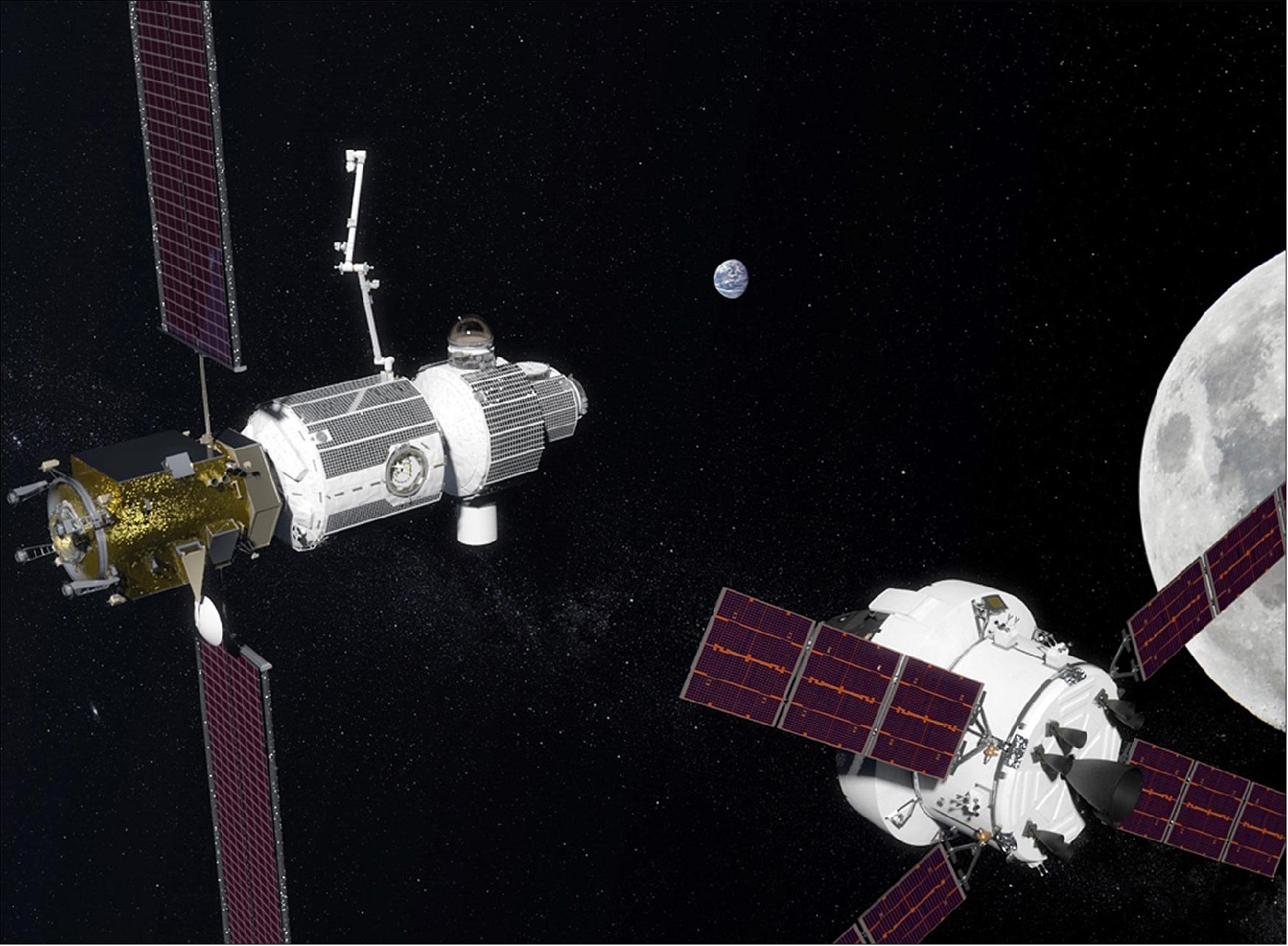
NASA wants to understand how U.S. industry would use or enhance the Gateway to support a growing space economy. The agency issued a Request for Information (RFI) June 18, 2018, to determine interest in technical solutions to meet exploration goals and possible contract or partnership interest to advance private sector demand. 3)
The Gateway will serve as the staging area for the agency's next phase of exploration, and will open up human and robotic exploration and breakthrough science on the Moon, and in deep space. It has unique characteristics and capabilities that may be of use to private companies for commercial applications.
"As we return to the Moon and push human exploration farther into the solar system, we want to expand our partnerships from low-Earth orbit to deep space," said Phil McAlister, director of Commercial Spaceflight Development at NASA Headquarters in Washington. "We believe partnering with U.S. industry to maximize the commercial utility of the Gateway will help enhance the economic development of space."
Results from the RFI will help inform NASA's development for Gateway requirements. For example, NASA is interested in understanding how moving the Gateway between orbits in the vicinity of the Moon may impact potential uses. Helping expand the commercial space business and seeking ideas from U.S. companies to support it keeps NASA apprised on developing external technologies and can guide the agency's future exploration.
Among other topics, NASA wants to hear from industry regarding potential frequency of visits to the Gateway; plans on how they would obtain crew or cargo transportation; resource requirements such as power and communications; and any potential barriers to commercial use of the Gateway.
NASA's return to the Moon with commercial and international partners is part of an overall agency Exploration Campaign in support of Space Policy Directive 1. New Commercial Lunar Payload Services or CLPS delivery missions will be among the first robotic steps back on the Moon, beginning as early as 2019. NASA will follow these early, small lander missions with the first of two larger lander demonstration missions planned in 2022. These larger lander missions will be an important step toward evolution to human landers, and are expected to be built through public/private partnerships.
NASA plans to conduct more research on the Moon's surface ahead of a human return. And that long-term exploration and development of the Moon will give NASA experience for the next giant leap – missions deeper into the solar system, including Mars.
Development Status
• June 15, 2022: The next steps in exploring and using space for the benefit of European citizens were this week on the agenda at ESA's Council meeting in ESA/ESTEC, the Netherlands on 14 and 15 June. The possibility of the first-ever European astronaut to set foot on the Moon, a telecommunication satellite for lunar exploration and a mission to return precious rock samples from Mars were all discussed. 4) 5)
- NASA Administrator Bill Nelson joined the meeting with ESA Member States in a decisive gesture to advocate for Europe's strong role in multiple projects which reinforce the enduring partnership between the two leading space agencies.
- "From understanding our changing planet to exploring Mars, I hugely value the cooperation we have with NASA" says ESA Director General Josef Aschbacher. "By contributing key European hardware and services to exciting programmes such as Artemis and Mars Sample Return, we are building Europe's autonomy while also being a reliable partner."
- "We are travelling farther out into the cosmos than ever before – and whether on the ISS in low-Earth orbit, at the Moon through our Artemis missions, on Mars and beyond, NASA and ESA's partnership in science and exploration shows us what is possible when we work together to develop groundbreaking science and technology for the benefit of humanity. NASA is counting on cooperation with ESA to propel exploration of the Moon through the Artemis programme. The European Service Module is the powerhouse of the Orion spacecraft, providing our astronauts with in-space maneuvring capabilities, life support, and power that will safely transport our astronauts to the Moon and back home to Earth" says Bill Nelson, NASA Administrator.
- "Europe plays an essential part in returning humans to the Moon. It is an exhilarating feeling to know that our modules are set for not just one, but several lunar trips before this decade is out," adds Josef Aschbacher.
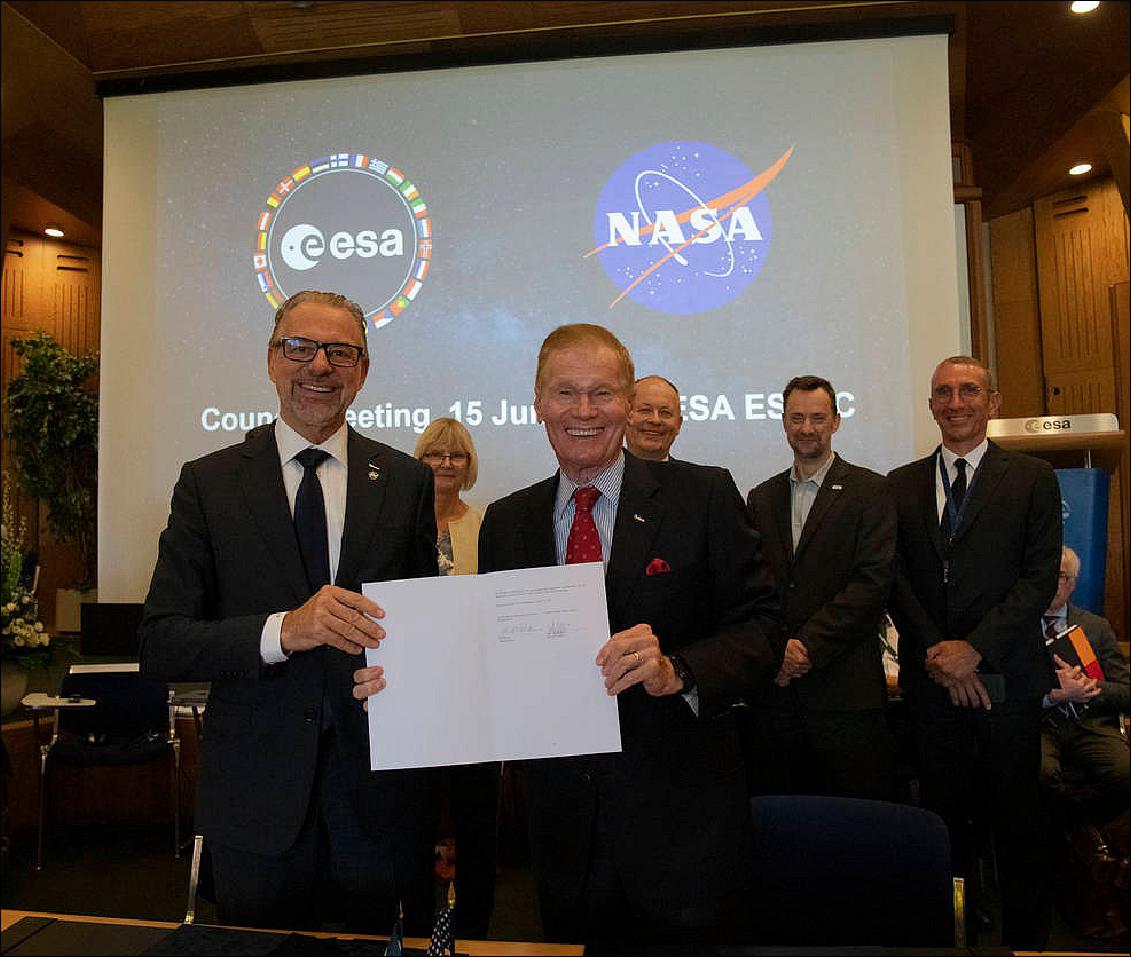
A European on the Moon?
- ESA's long-term provision of service modules for the Orion spacecraft ensures that NASA's Artemis programme can send astronauts to the Moon and beyond. Already, ESA provides service modules as part of its contribution for the International Space Station programme, and there is now an agreement in place to fly three ESA astronauts aboard Orion to the deep space outpost that the international partners are now building and known as the Gateway.
- But this strategic partnership is now setting the path for the first-ever European astronaut to land on the Moon.
- "We look forward to having an ESA astronaut join us on the surface of the Moon and continuing to build on our longstanding, critical partnership" says NASA Administrator Bill Nelson.
- A ride to the surface of the Moon for a European could be the benefit of fresh ESA contributions to Artemis. European contributions could include delivery of cargo and infrastructure to the Moon by the European Large Logistic Lander (EL3) to be named Argonaut, communication and navigation services through the proposed Moonlight programme as well as science and technology for surface exploration. These projects among others will be on the table for discussion at the ESA Council of Ministers in Paris later this year.
Building the Lunar Economy
- A key step towards this vision was agreed in an innovative agreement signed by the ESA Director General and the NASA Administrator at the ESA Council.
- The UK company SSTL is already building Lunar Pathfinder, the first commercial lunar telecommunications relay satellite available for users worldwide. ESA signed-up last year to buy services from SSTL. Going forward, NASA and ESA will combine forces: NASA will deliver Lunar Pathfinder to lunar orbit through the Commercial Lunar Payload Services initiative and ESA will provide NASA with access to lunar telecommunications. Further, in a unique ESA-NASA collaboration, tests will be made of using satellite navigation signals and laser ranging to demonstrate a satnav positioning fix in lunar orbit for the first time.
- These tests will be a valuable step towards Moonlight, whose vision is to create a network of communications and navigation satellites supporting Lunar exploration, just as today we navigate using Galileo and GPS on Earth.
- "Thanks to this Memorandum of Understanding between the two space agencies, we are empowering sustainable lunar exploration while supporting commercial European businesses" says David Parker, ESA's Director of Human and Robotic Exploration.
- UK Space Agency CEO Paul Bate welcomed the signing of the agreement between ESA DG and NASA Administrator, Bill Nelson that enables UK company SSTL to provide communications relay services to missions in lunar orbit and on the surface of the Moon.
- "I am delighted to see this next step in the cooperation between ESA, NASA and UK industry" said UK Space Agency Chief Executive, Paul Bate. "Space is an essential growth area of the UK economy, and it is exciting to see this now extending even to the Moon. If we ever needed confirmation that Space is a team sport, this is it."
Martian Horizons
- ESA and NASA are assessing collaboration efforts to implement the mission of the ExoMars rover ‘Rosalind Franklin'. The rover was designed and built to perform as a mobile surface science laboratory platform for drilling Mars soil and conducting science experiments in-situ. NASA has provided key elements of one of the life-search instruments for Rosalind Franklin, MOMA, and already uses the ExoMars Trace Gas Orbiter for relaying science data from its landers and rovers.
- ESA's science and engineering teams are working on a fast-track industrial study to better define the available options for a way forward to implement the ExoMars rover mission.
- "In deepening our partnership in Mars exploration, which also includes the ground-breaking Mars Sample Return campaign, NASA is determining how best to support our European friends on the ExoMars mission, says NASA Administrator, Bill Nelson.
- "Meanwhile, we will continue to work together on refining the architecture of Mars Sample Return", added Josef Aschbacher. "Overall, we want to achieve the best scientific return from our collective investments, on both sides of the Atlantic."
- ESA Member States will further discuss the way forward for Rosalind Franklin at their July Council meeting.
Looking Back at Earth
- ESA and NASA have also signed a Framework Agreement for a Strategic Partnership in Earth System Science. The two agencies plan to lead a global response to climate change, through the monitoring of the Earth and its environment with combined efforts in Earth science observations, research, and applications, in support of adaptation and mitigation measures.
- The unprecedented strategic partnership sets the standard for future international collaboration and ensures data from Earth-observing satellites are used to their best advantage, further science and, ultimately, bring the most benefit to humankind. The themes include observing systems to ensure sustained observations, collaboration on data policy and exploitation, as well as open science.
- "When it comes to global challenges such as the climate crisis, we each have our role to play," concludes Josef Aschbacher, ESA Director General, "but it's only by joining forces that we can achieve more", adding "with leadership on both sides of the Atlantic more committed to tackle this than ever, ESA and NASA have a historic chance to further make space an integral part of the solution when it comes to climate change mitigation."
• February 18, 2022: ESA astronaut Alexander Gerst visited Thales Alenia Space in Turin recently to test out and provide feedback on accommodations for the next human outpost in space, the lunar Gateway. 6)
- As the name implies, the Gateway will be located within the Moon's orbit and is being built by Thales Alenia Space on behalf of ESA. Among its components is the International Habitation Module or I-Hab.
- As crew quarters are designed with humans in mind, Alex both toured the mock-up and stepped into the crew quarter simulator to provide some experienced feedback. After two missions to the International Space Station – Blue Dot (2014) and Horizons (2018) – totalling 362 days in space, Alex is no stranger to living in special conditions.
- Using virtual gear, Alex experienced an immersive environment representing the interior of I-Hab, as if he were present on the lunar Gateway in orbit around the Moon. What did he think?
- Overall, the feedback was positive. Alex provided some recommendations that will help Thales Alenia Space's design team improve the next iterations.
- Alex and fellow ESA astronaut Luca Parmitano similarly assisted this process in 2021, but due to COVID-19 restrictions were only able to do so remotely.
- Involving astronauts in the module design process allows engineers to capitalise on the astronauts' experience aboard the International Space Station. Their feedback will guide upcoming design phases, to support a user-centered approach.
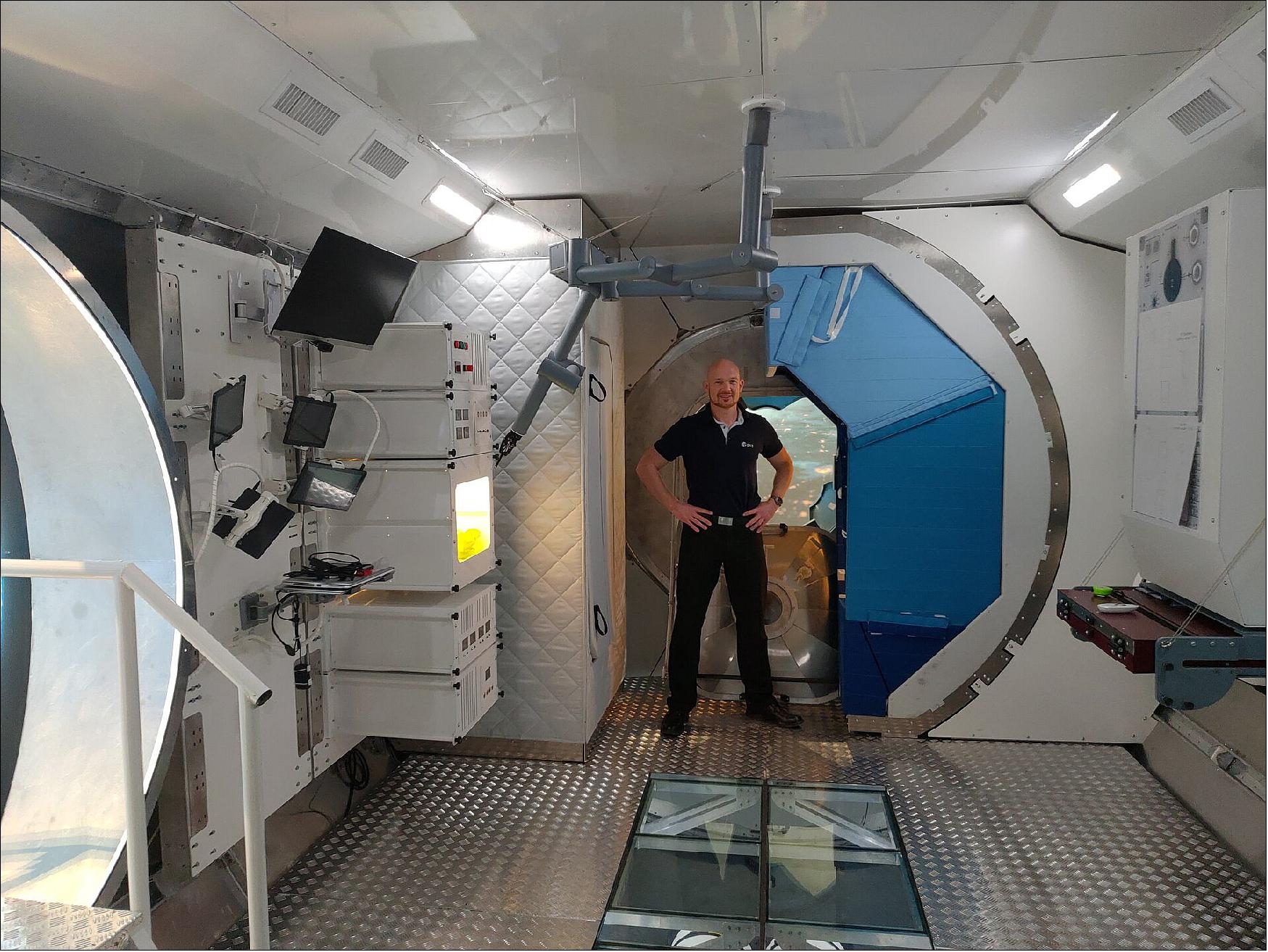
- "Exciting to see and work on the future of lunar exploration," said Alex. "The Gateway will be different to the International Space Station but an evolution of over two decades of living and working in low-Earth orbit. Next destination: lunar orbit."
- I-Hab is a major part of the Gateway, and together with the communications and refuelling module ESPRIT and ESA's service module for the lunar spacecraft Orion, Europe is proving to be a vital partner in the Artemis programme and humankind's return to the Moon.
• January 11, 2022: Airbus Crisa, an affiliate company of Airbus, has signed a contract for the development of the Power Management and Distribution (PMAD) system for the Habitation and Logistics Outpost (HALO) with Northrop Grumman. 7)
- Airbus Crisa is a Spanish company founded in 1985 to design and manufacture electronic equipment and software for space applications, and engineering projects for ground stations. It is fully integrated into Airbus Defence and Space.
- The new Lunar Gateway station, scheduled for launch in 2024, will initially have two modules and will be expanded in successive years to five modules. The station is intended to serve as a space laboratory as well as an intermediate logistics post for future trips to the surface of the Moon and on to Mars. The two initial modules are known as PPE and HALO. PPE (Power and Propulsion Element) has solar arrays that power the station and thrusters that allow it to maintain a stable orbit around the Moon. HALO is the Habitation and Logistics Outpost module where the astronauts will live during the estimated 40 days of the first missions.
- "This contract worth more than $50 million reflects our ability to deliver highly specialized space equipment to global manufacturers and is our first contribution to the Moon-orbiting Gateway, which is part of NASA's Artemis programme to return to the Moon," said Fernando Gómez-Carpintero, CEO of Airbus Crisa. "This is an exciting step as Airbus Crisa is designing the PMAD to become the standard modular power management system for all future space stations and human vehicles. We have provided a disruptive solution, with an architectural concept never before seen in the sector. This lays the foundations for a new international standard, placing the company at the forefront of the sector."
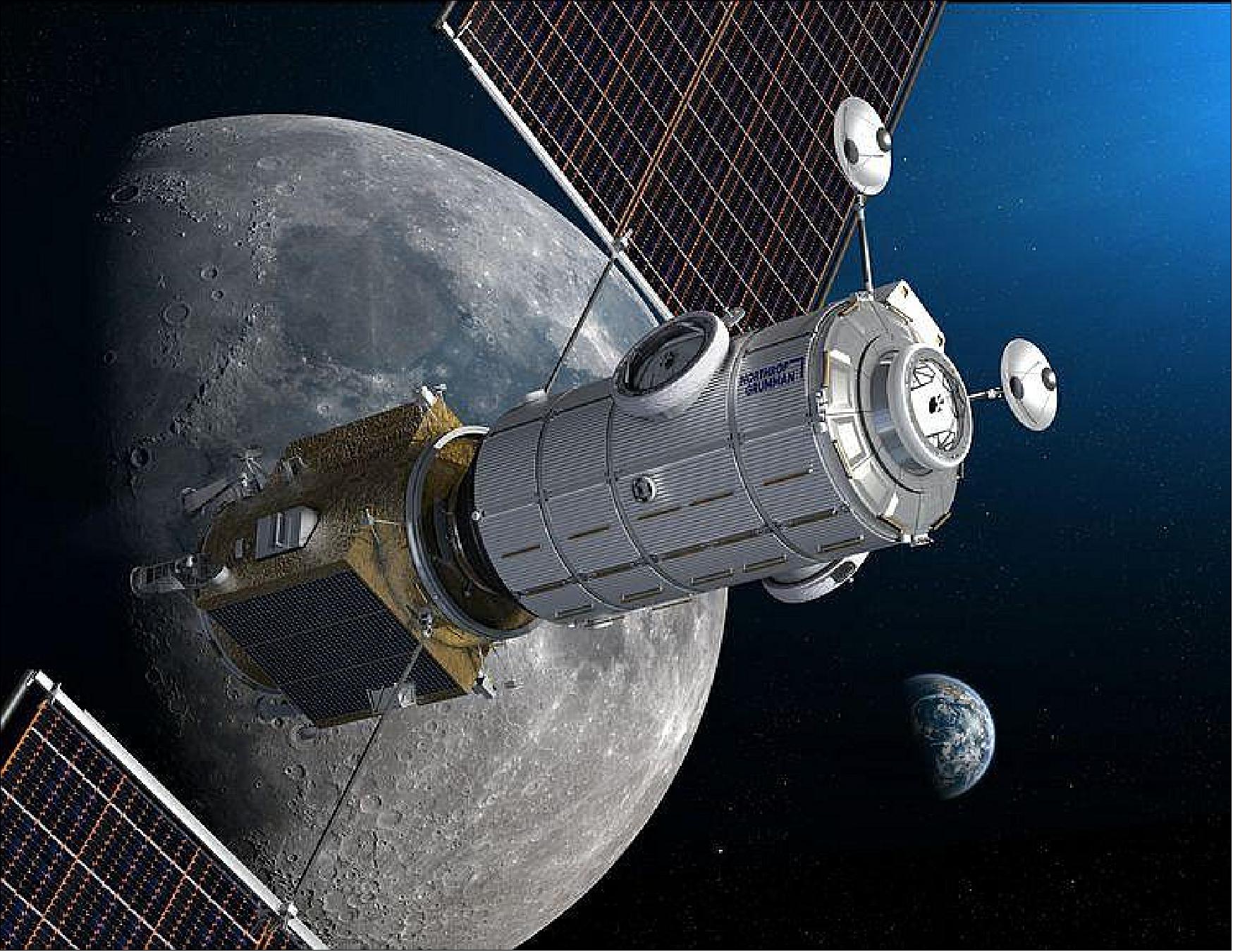
- The PMAD has four power units and will manage the electricity from the solar panels of the Power and Propulsion Element (PPE). It will distribute the power to onboard equipment and the rest of the station as required, always ensuring the safety of the crew on board. The PMAD will power the life support system, the interior lighting, the communications systems and the scientific experiments. It will ensure that HALO's battery remains at optimal levels and is ready for use when the panels do not receive sufficient sunlight. PMAD must also provide power to visiting vehicles when they dock.
- Airbus Crisa is a key international player in the fields of power conversion digital control and energy management and distribution for satellite and launcher applications thanks to the experience gained in the challenging ESA exploration missions. This contract demonstrates its great potential to provide reliable flight products to US manufacturers.
• December 21, 2021: Gateway will be an outpost orbiting the Moon that provides vital support for a long-term human return to the lunar surface, as well as a staging point for deep space exploration. It is a critical component of NASA's Artemis program. 8)
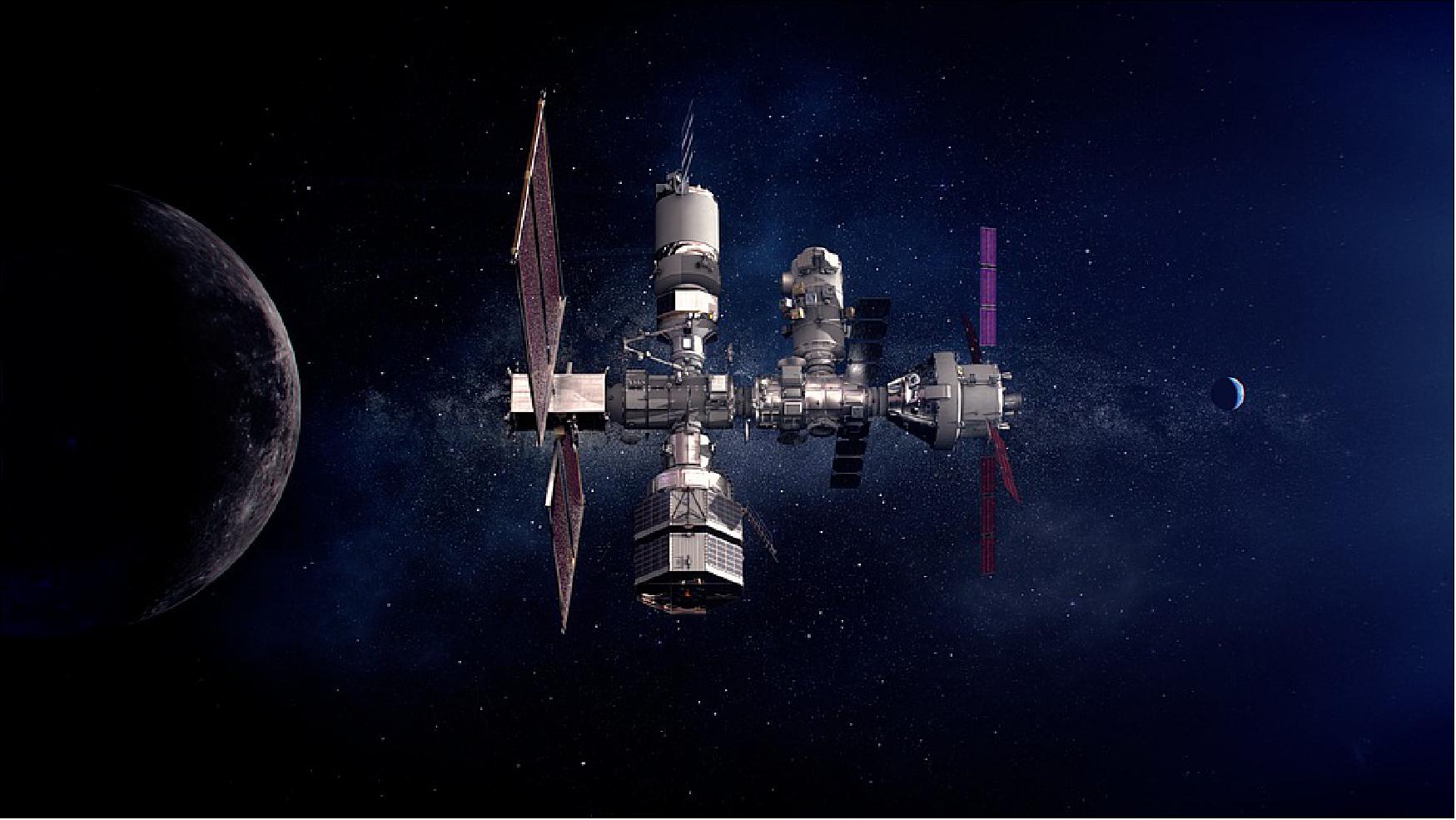
- The Gateway is a vital part of NASA's deep space exploration plans, along with the Space Launch System (SLS) rocket, Orion spacecraft, and human landing system that will send astronauts to the Moon. Gaining new experiences on and around the Moon will prepare NASA to send the first humans to Mars in the coming years, and the Gateway will play a vital role in this process. It is a destination for astronaut expeditions and science investigations, as well as a port for deep space transportation such as landers en route to the lunar surface or spacecraft embarking to destinations beyond the Moon.
- NASA has focused Gateway development on the initial critical elements required to support the landing – the Power and Propulsion Element, the Habitation and Logistics Outpost (HALO) and logistics capabilities.
PPE (Power and Propulsion Element)
- PPE is a high-power, 60 kW solar electric propulsion spacecraft that will provide power, high-rate communications, attitude control, and orbital transfer capabilities for the Gateway.
- In May 2019, NASA selected Maxar Technologies of Westminster, Colorado, to develop, build, and support an in-space demonstration of the element.
- The PPE is managed out of NASA's Glenn Research Center in Ohio.
HALO (Habitation and Logistics Outpost)
- The Habitation and Logistics Outpost will be the initial crew cabin for astronauts visiting the Gateway. Its primary purpose is to provide basic life support needs for the visiting astronauts after they arrive in the Orion and prepare for their trip to the lunar surface. It will provide command, control, and data handling capabilities, energy storage and power distribution, thermal control, communications and tracking capabilities, as well as environmental control and life support systems to augment the Orion spacecraft and support crew members. It also will have several docking ports for visiting vehicles and future modules, as well as space for science and stowage.
- HALO is being developed by Northrop Grumman and is managed out of NASA's Johnson Space Center in Houston.
Deep Space Logistics
- As astronauts prepare for missions to the lunar surface, they will need deliveries of critical pressurized and unpressurized cargo, science experiments and supplies, such as sample collection materials and other items. In March 2020, NASA announced SpaceX as the first U.S. commercial provider under the Gateway Logistics Services contract to deliver cargo and other supplies to the Gateway. One logistics services delivery is anticipated for each crewed Artemis mission to the Gateway.
- Gateway Logistics is based at NASA's Kennedy Space Center in Florida.
- While the Gateway Program is led out of JSC, Deep Space Logistics (DSL) is the Gateway Project office at KSC responsible for leading the commercial supply chain in deep space by procuring services for transporting cargo, equipment and consumables to enable exploration of the Moon and Mars. Kennedy's Deep Space Logistics office is the focal point for all Gateway activities conducted at the spaceport, including:
a) Commercial acquisition and contract management
b) End-to-end commercial service mission management, insight, and approval
c) Spaceport host for commercial, deep space logistics, payload processing and delivery services.
Initial Launch
- In February 2021, NASA selected SpaceX to provide launch services for PPE and HALO. After integration on Earth, the PPE and HALO are targeted to launch together no earlier than November 2024 on a Falcon Heavy rocket from Launch Complex 39A at Kennedy.
Gateway's Future
- Gateway international partners will provide important contributions to the lunar outpost, comprising advanced external robotics, additional habitation, refueling capability, and possibly other enhancements. Canada announced in February 2019 its intention to participate in the Gateway and contribute advanced external robotics. In December 2020, the Canadian Space Agency awarded a contract to MDA to build the Canadarm3 for Artemis deep space missions. In October 2019, Japan announced plans to join the United States on the Gateway with contributions of habitation components and logistics resupply. In November 2019, the European Space Agency (ESA) received authorization and funding to support its contributions to the Gateway including habitation and refueling. In October 2020, ESA signed an agreement with NASA to contribute habitation and refueling modules and enhanced lunar communications to the Gateway. ESA also provides two additional European Service Modules for NASA's Orion spacecraft. In November 2020, Canada signed a Gateway agreement to contribute external robotics and in December 2020, Japan signed an agreement to partner with NASA on the Gateway as well.
• July 16, 2021: The House Appropriations Committee passed a spending bill July 15 that leaves intact overall funding for NASA but tweaks language regarding the Human Landing System and nuclear thermal propulsion. 9)
- The committee voted 33–26 to advance the commerce, justice and science (CJS) appropriations bill to the full House. The bill allocated $81.3 billion in funding for fiscal year 2022, including $25.04 billion for NASA.
- The vote came after several hours of debate on amendments, most of which did not involve NASA. Members did swiftly approve on a voice vote one amendment, offered by Rep. Ben Cline (R-Va.), that requires $80 million of the $110 million included in the bill for nuclear thermal propulsion (NTP) research at NASA go toward work on a light demonstration.
- At the CJS subcommittee markup July 12, Rep. Robert Aderholt (R-Ala.) had criticized the bill for not including that NTP flight demonstration language, which had appeared in past versions of the bill in recent years. "The omission imperils the progress of, and our previous investments in, nuclear thermal propulsion capabilities," he said then.
- The markup came a day after the committee released the report accompanying the bill, which provided more information on funding levels within NASA. The report originally specified $1.345 billion for the Human Landing System (HLS) program but expressed concern about NASA's decision to select only one company, SpaceX, for an award in April. The committee "believes that continued agency investment beyond the HLS Option A Contract Award is vital to ensure continued competition among potential HLS providers," the report stated, endorsing the latest effort as part of the Next Space Technologies for Exploration Partnerships (NextSTEP) program "to continue robust competition among potential providers for a future sustained HLS services capability."
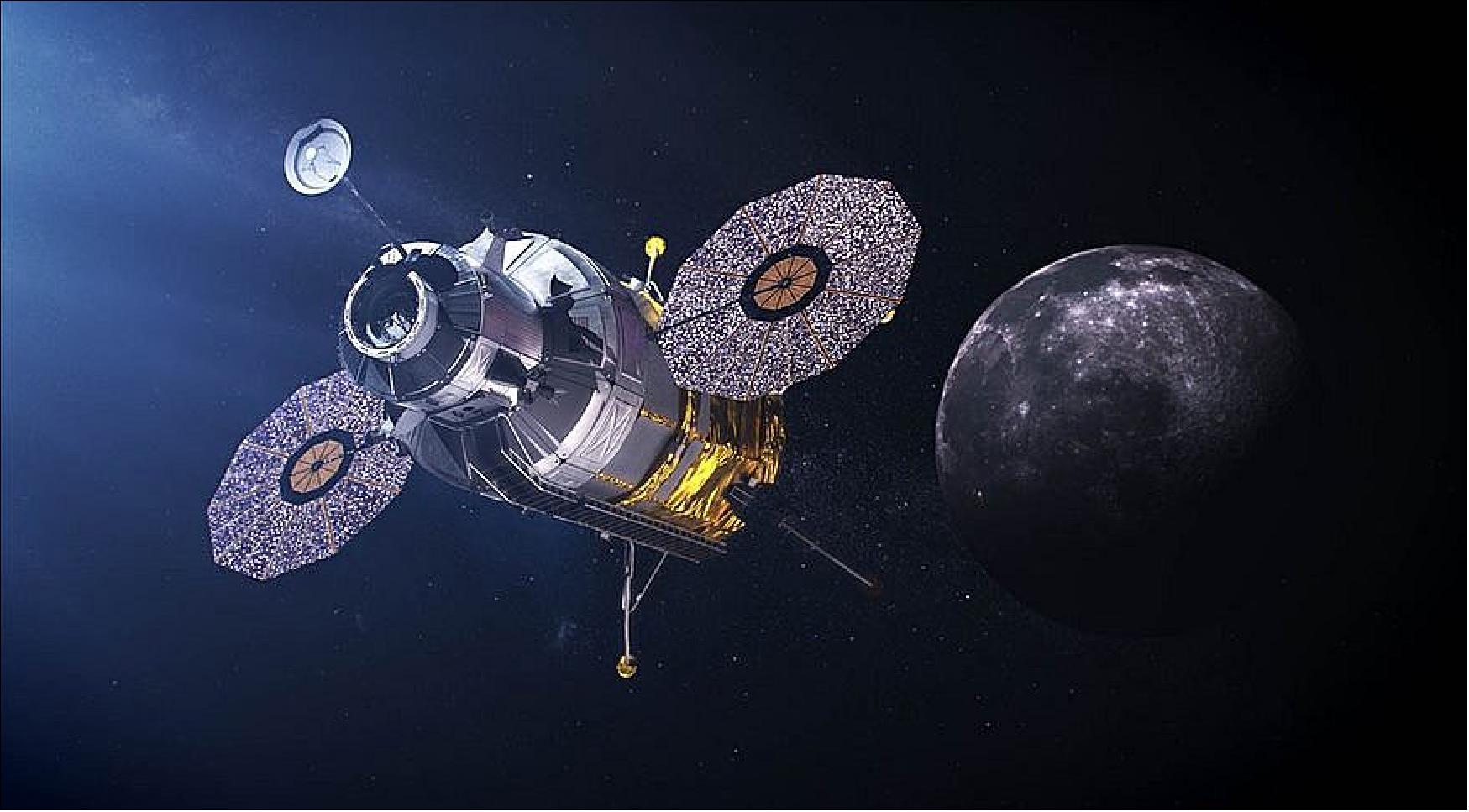
- A manager's amendment to the bill and report, passed by the committee on a voice vote, altered that language. While retaining the $1.345 billion for HLS, it stated the committee "elected not to further fence of condition funds for the Human Landing System at this time" because of the ongoing protests of the award being considered by the Government Accountability Office. The committee instead "urges NASA to bolster competition in lander development and production and improve the United States' prospects for landing astronauts on the Moon in 2024."
- Aderholt had drafted an amendment that would have gone further on HLS. It would have directed NASA to select a second HLS company "as soon as practicable" with a minimum of $250 million in fiscal year 2022, and allowing that company to use a Space Launch System Block 1B rocket for its lander's demonstration mission. The same amendment also backed development of a cargo version of SLS, at least one of which would launch no later than 2032.
- Aderholt withdrew the amendment before the markup, but in brief comments about the manager's amendment during the markup mentioned working with committee leadership on the revised HLS language.
- Another provision of the report restores funding for NASA's Stratospheric Observatory for Infrared Astronomy (SOFIA), an airborne observatory that the agency proposed shutting down in its budget request for the second consecutive year. The report provides $85.2 million, full funding, for SOFIA in 2022. "SOFIA can undertake astronomical observations not possible with other ground-based or space-based telescopes available today," the report argued.
- The report, while increasing funding for the SLS by nearly $150 million versus the administration's request, does call on NASA to find ways to reduce the vehicle's cost. It asks NASA to "engage an independent reviewer with aerospace production management experience to conduct a review of SLS completion costs" and "to determine how the cost of future flights of the SLS can be reduced."
- Although the bill cuts funding for NASA's low Earth orbit commercialization efforts, citing a lack of "clear goals and metrics" for transitioning from the International Space Station, it does support a separate agency initiative to fly people on commercial suborbital vehicles. NASA's Suborbital Crew program would get $10 million as part of the overall commercial crew effort, funding flights of non-NASA personnel on suborbital vehicles and directing NASA to "assess whether it should establish a relevant program office to qualify commercial U.S. suborbital vehicles and procure flights for NASA personnel."
• July 12, 2021: Maxar Technologies today announced that the Power and Propulsion Element (PPE) it is developing for NASA's lunar Gateway has passed its first Preliminary Design Review (PDR) and remains on track for launch in 2024. PPE is the foundational element of NASA's lunar Gateway. 10)
- Passing PDR-1 means that Maxar expects to finalize the PPE system-level design over the next year, culminating in the Critical Design Review in May 2022. A second PDR this fall will verify that the evolved PPE design meets mission requirements and is cleared for final design review and fabrication. During this period, Maxar will continue to take delivery of flight hardware units based on the company's 1300-class spacecraft platform.
- Maxar's PPE is the foundational element of the Gateway, providing power, maneuvering, attitude control and communications systems for the lunar orbiting outpost. Gateway is a cornerstone of NASA's Artemis program, which aims to land the first woman and first person of color on the moon and enable future crewed missions to Mars. PPE is managed by NASA's Glenn Research Center in Cleveland, Ohio.
- In 2020, NASA introduced new requirements, including the integration of the PPE with Northrop Grumman's Habitation and Logistics Outpost (HALO) on the ground to enable launch of both modules together on a single SpaceX Falcon Heavy launch vehicle. This change reduced Gateway's risk profile and increased its cost effectiveness, necessitating the need for a second PDR that reflects the evolved program design.
- Maxar's 1300-class spacecraft are currently supporting the following NASA missions:
a) PPE, the highest power solar electric propulsion spacecraft ever built
b) Psyche, a deep space mission to a metal-rich asteroid
c) OSAM-1, an on-orbit assembly, manufacturing and refueling demonstration
d) TEMPO, a climate sensor hosted on a commercial communications satellite
- "Clearing this development milestone for PPE is a significant accomplishment," said Chris Johnson, Maxar's Senior Vice President of Space Program Delivery. "PPE is one of several NASA programs built on Maxar's trusted 1300-class spacecraft platform, which leverages decades of our commercial design, manufacturing and operations expertise. At Maxar, our team is agile, and our spacecraft are versatile. The progress we have made on PPE is further evidence that we are prepared to meet a broad range of civil, commercial and national security mission needs."
• July 9, 2021: NASA and Northrop Grumman of Dulles, Virginia, have finalized a contract to develop the Habitation and Logistics Outpost (HALO) for Gateway, which will be a critical way station and outpost in orbit around the Moon as part of NASA's Artemis program. 11)
- NASA and its commercial and international partners are building Gateway to support science investigations and enable surface landings at the Moon, which will help prepare astronauts for future missions to Mars.
- The firm, fixed-price contract is valued at $935 million. Under the contract, Northrop Grumman will be responsible for attaching and testing the integrated HALO with the Power and Propulsion Element (PPE), being built by Maxar Technologies. Northrop Grumman will also lead the integrated PPE and HALO spacecraft turnover and launch preparation with SpaceX, and support activation and checkout of HALO during the flight to lunar orbit. NASA is targeting November 2024 to launch the integrated spacecraft on a SpaceX Falcon Heavy rocket.
- "NASA is building the infrastructure to expand human exploration further out into the solar system than ever before, including Gateway, the lunar space station that will help us make inspirational scientific discoveries at and around the Moon. Just as importantly, these investments will help NASA carry out the United States' horizon goal: to further develop and test the technology and science needed for a human trip to Mars," said NASA Administrator Bill Nelson. "The HALO is a critical component of Gateway, and this exciting announcement today brings us one step closer to landing American boots on both the Moon and Mars."
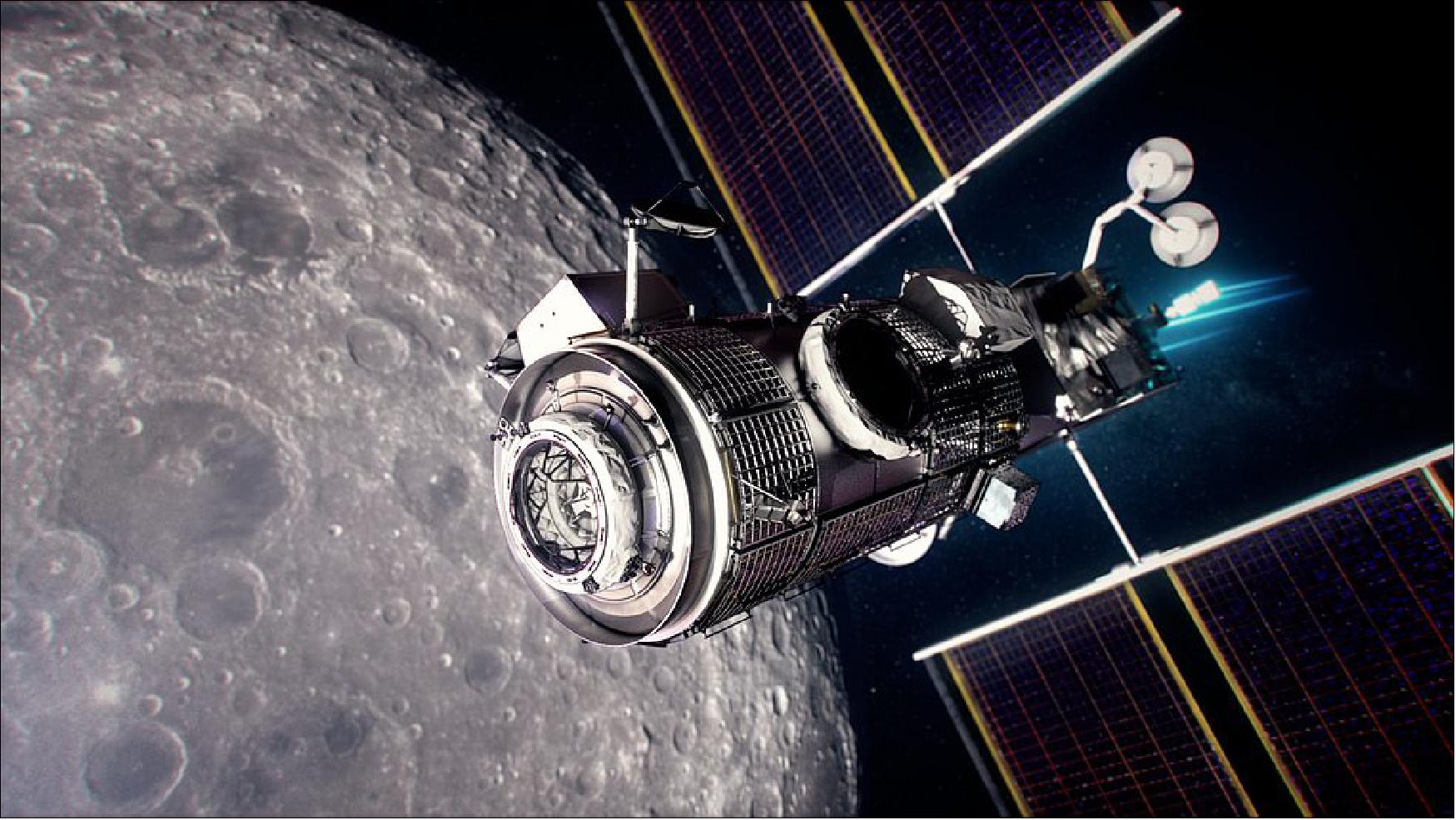
- HALO is where astronauts will live and conduct research while visiting the Gateway. The pressurized living quarters will provide command and control systems for the lunar outpost, and docking ports for visiting spacecraft, such as NASA's Orion spacecraft, lunar landers, and logistics resupply craft. The HALO module will serve as the backbone for command and control and power distribution across Gateway and will perform other core functions, including hosting science investigations via internal and external payload accommodations and communicating with lunar surface expeditions. HALO also will enable the aggregation of additional habitable elements to expand Gateway capabilities. Immediately after launch, the Heliophysics Environmental and Radiation Measurement Experiment Suite, built by NASA's Goddard Space Flight Center in Greenbelt, Maryland, will begin conducting research outside of the integrated spacecraft.
- "This is a major step on the path for Artemis, not just for NASA, but for the combined team, including our commercial and international partners," said Kathy Lueders, NASA associate administrator for Human Explorations and Operations. "Gateway will provide unprecedented access to the Moon and symbolizes the expansion of our partnerships into deep space."
- The integrated PPE and HALO will be the Gateway's foundation, enabling humanity's first permanent outpost in orbit around the Moon. Located tens of thousands of miles from the lunar surface at its farthest point and within easy range of lunar landers at its closest, the Gateway will be in a near-rectilinear halo orbit. This orbit will allow NASA and its international and commercial partners to conduct unprecedented deep space science and technology investigations, and conduct sustainable lunar exploration.
- "This action puts in place the final contract component of a diverse, multi-faceted team –distributed across the country and within some international partner facilities – working together to create and implement the initial Gateway capability. We are excited to work with Northrop Grumman and all the partners to deliver the cornerstone of sustainable human exploration in cis-lunar space," said Dr. Jon Olansen, NASA's manager of the HALO project.
- HALO leverages contributions from the Gateway international partners for robust capabilities. Batteries provided by the Japan Aerospace Exploration Agency (JAXA) will power HALO until PPE solar arrays can be deployed and during eclipse periods. Robotic interfaces provided by the Canadian Space Agency will host payloads and provide base points for Canadarm3 robotic operations. ESA (European Space Agency) will provide a lunar communications system to enable high-data-rate communications between the lunar surface and Gateway. With three docking ports, HALO will be the hub for international Gateway expansion in the future, including an international habitat that ESA and JAXA will provide, and an ESA-provided refueling module. The docking ports also will host a human landing system for lunar surface expeditions and logistics resupply spacecraft. As the Gateway hub, HALO will provide power, data, airflow to each of these ports, as well as thermal conditioning to assist future elements and spacecraft in controlling the temperature of their equipment and habitable environment.
- "Leveraging our success with our Cygnus spacecraft, Northrop Grumman is perfectly positioned to deliver the HALO module, a critical piece for NASA's Artemis program and our journey to the Moon and beyond," said Frank DeMauro, vice president and general manager for tactical space systems at Northrop Grumman. "After recently completing a successful preliminary design review, we now look forward to completing the detailed design efforts and eventually bringing HALO to life in our Gilbert, Arizona, facility while also providing integration services for the final, combined vehicle before launch."
- HALO's design is based on Northrop Grumman's Cygnus spacecraft, which has completed 15 resupply missions to the International Space Station to date. A previous contract for HALO, awarded in June 2020, funded work through preliminary design review, one of a series of checkpoints for the complex engineering project. The review process for the module, completed in May, assessed all of the spacecraft's design to ensure the overall system is safe and reliable for flight and meets NASA's mission requirements.
• January 13, 2021: NASA and the Government of Japan have finalized an agreement for the lunar Gateway, an orbiting outpost that commercial and international partners will build together. This agreement strengthens the broad effort by the United States to engage international partners in sustainable lunar exploration as part of the Artemis program and to demonstrate the technologies needed for human missions to Mars. 12)
- Under this agreement, Japan will provide several capabilities for the Gateway's International Habitation module (I-HAB), which will provide the heart of Gateway life support capabilities and additional space where crew will live, work, and conduct research during Artemis missions. The Japan Aerospace Exploration Agency's (JAXA) planned contributions include I-HAB's environmental control and life support system, batteries, thermal control, and imagery components, which will be integrated into the module by the European Space Agency (ESA) prior to launch. These capabilities are critical for sustained Gateway operations during crewed and uncrewed time periods.
- "We're honored to announce this latest agreement with Japan to support long-term human exploration on and around the Moon as part of the Artemis program," said NASA Administrator Jim Bridenstine. "Strengthening our international partnerships and commitments to Artemis puts humanity on a solid path to achieve our common goals of sustainable lunar exploration by the end of this decade."
- Under an arrangement with Northrop Grumman, Japan also will provide batteries for the Gateway's Habitation and Logistics Outpost (HALO), the initial crew cabin for astronauts visiting the Gateway. Additionally, Japan is investigating enhancements to its HTV-X cargo resupply spacecraft, which could result in its use for Gateway logistics resupply.
- "Leveraging the capabilities that international partners contribute to Gateway will be key to enabling access to the lunar surface," said Kathy Lueders, associate administrator for the Human Exploration and Operations Mission Directorate at NASA Headquarters. "We are pleased to move forward in these groundbreaking efforts with Japan and our other partners."
- The agreement also marks NASA's intent to provide crew opportunities for Japanese astronauts to the Gateway, which will be determined following additional discussions, and documented in a future arrangement.
- Approximately one-sixth the size of the International Space Station, the Gateway will serve as a rendezvous point for astronauts traveling to lunar orbit aboard NASA's Orion spacecraft and Space Launch System rocket prior to transit to low-lunar orbit and the surface of the Moon. From the Gateway, NASA and its partners will use this lunar vantage point as a springboard for robotic and human expeditions to the Moon, and on to Mars.
- "The capabilities provided by Japan are critical to enabling the interior environment of the Gateway allowing our crews to live and work for longer durations," said Dan Hartman, Gateway program manager at NASA's Johnson Space Center in Houston. "With the life support systems from Japan, longer duration missions for the Artemis crews can be accomplished with reduced demands on logistics resupply."
- NASA astronauts will board a commercially developed lander for the final leg of the journey to the lunar surface, and the agency has contracted with U.S. industry to develop the first two Gateway components, the Power and Propulsion Element (PPE) and the HALO, as well as the logistics resupply for Gateway.
- Japan joins two other international partners in committing to the Gateway with NASA. In November 2020, the United States and Canada signed an agreement to collaborate on the Gateway. CSA's planned contributions include the outpost's external robotics system, robotic interfaces, and end-to-end robotic operations. In October 2020, NASA and ESA signed an agreement solidifying ESA's contributions to the Gateway, which include ESA's provision of the I-HAB module and refueling modules, along with enhanced lunar communications.
- In March 2020, NASA selected the first two scientific investigations to fly aboard the Gateway, one from NASA and the other from ESA. NASA and Gateway's international partners will collaborate to share the scientific data that will be transmitted to Earth. Additional scientific payloads will be selected in the future to fly aboard the outpost.
- In addition to supporting scientific research conducted by robotic and human lunar surface missions, the Gateway will support activities to test the technologies needed for human missions to Mars. For example, NASA will use the Gateway to demonstrate remote management and long-term reliability of autonomous spacecraft systems and other technologies.
• January 7, 2021: ESA signed a contract today with Thales Alenia Space to start building the European module for the lunar Gateway that will provide the new human exploration facility with communications and refueling. 13)
- The Gateway is being built by the partners of the International Space Station and will enable sustainable exploration around – and on – the Moon, while allowing for space research and demonstrating the technologies and processes necessary to conduct a future mission to Mars.
- The ESPRIT (European System Providing Refueling, Infrastructure and Telecommunications) will be a cylindrical module with space for astronauts to work in, much like an International Space Station module. It will include an observatory offering 360° views of the Moon and spacecraft as they dock with the lunar outpost.
- ESPRIT will consist of two main elements: a system to provide data, voice and video communications from the Gateway to the Moon and a refueling module that will provide the Gateway with xenon and chemical propellants. The refueling element will ensure Gateway has fuel for maintaining its orbit as well as supporting future reusable lunar landers and further deep space transport.
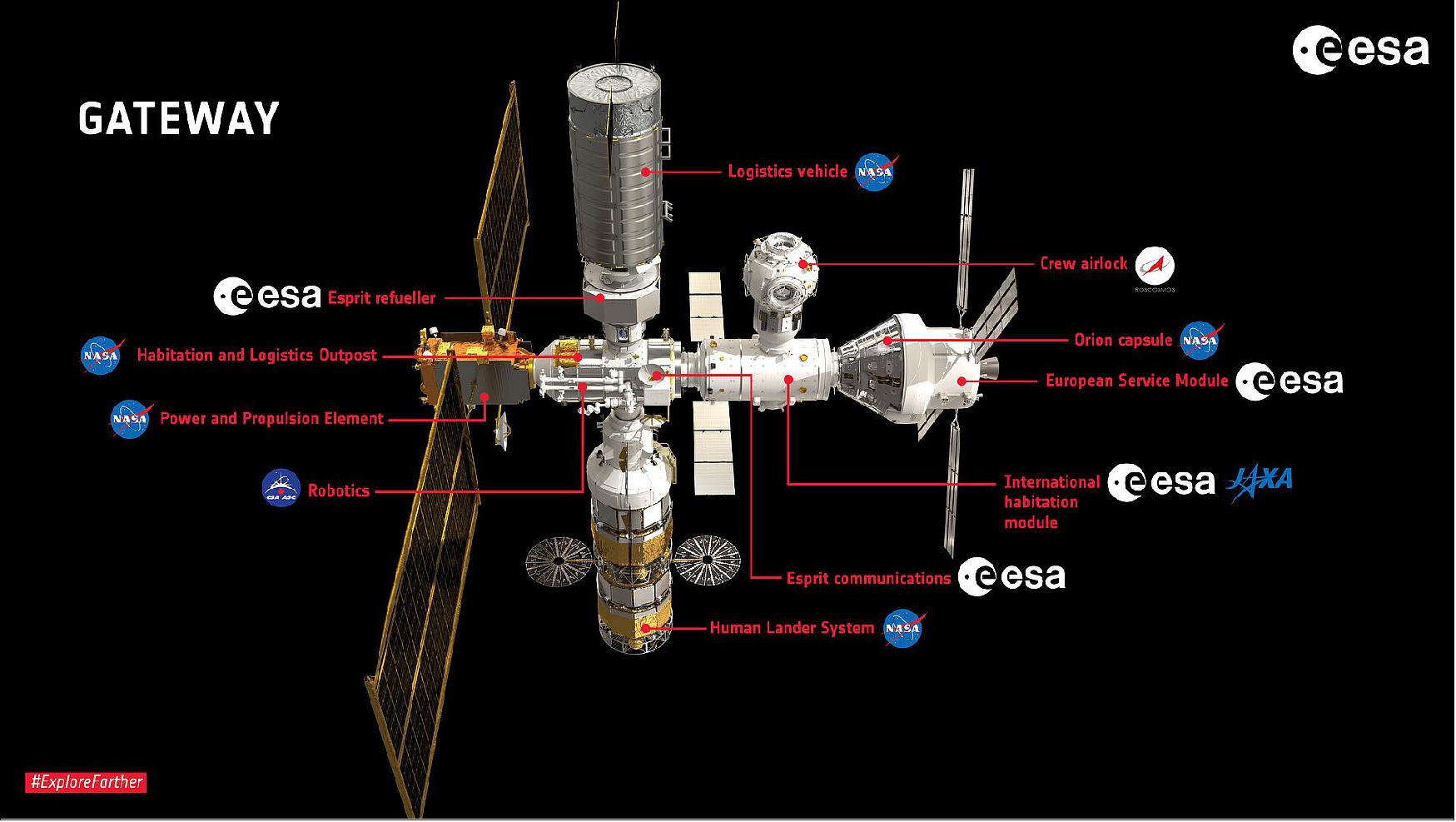
- The communications element is under fast-track development for launch in 2024 – mounted on the first US Gateway module, named HALO (Habitation and Logistics Outpost) – while the refueling module will be ready for launch in 2026. The contract is worth 296.5 million Euros and will see the module being built by Thales Alenia Space in Cannes, France, in a joint effort with Thales Alenia Space in Italy and the United Kingdom.
- "Development of the Gateway is accelerating thanks to this new contract and European expertise," says David Parker, ESA's Director of Human and Robotic Exploration. "In just a few years we will witness humankind – including European astronauts – working together in orbit around the Moon and supporting surface exploration. Coming on top of our existing contributions to Orion and the recent contract for the International Habitation module, I-HAB, Europe is now a core partner in Artemis, contributing to lunar transportation, infrastructure, technology and science."
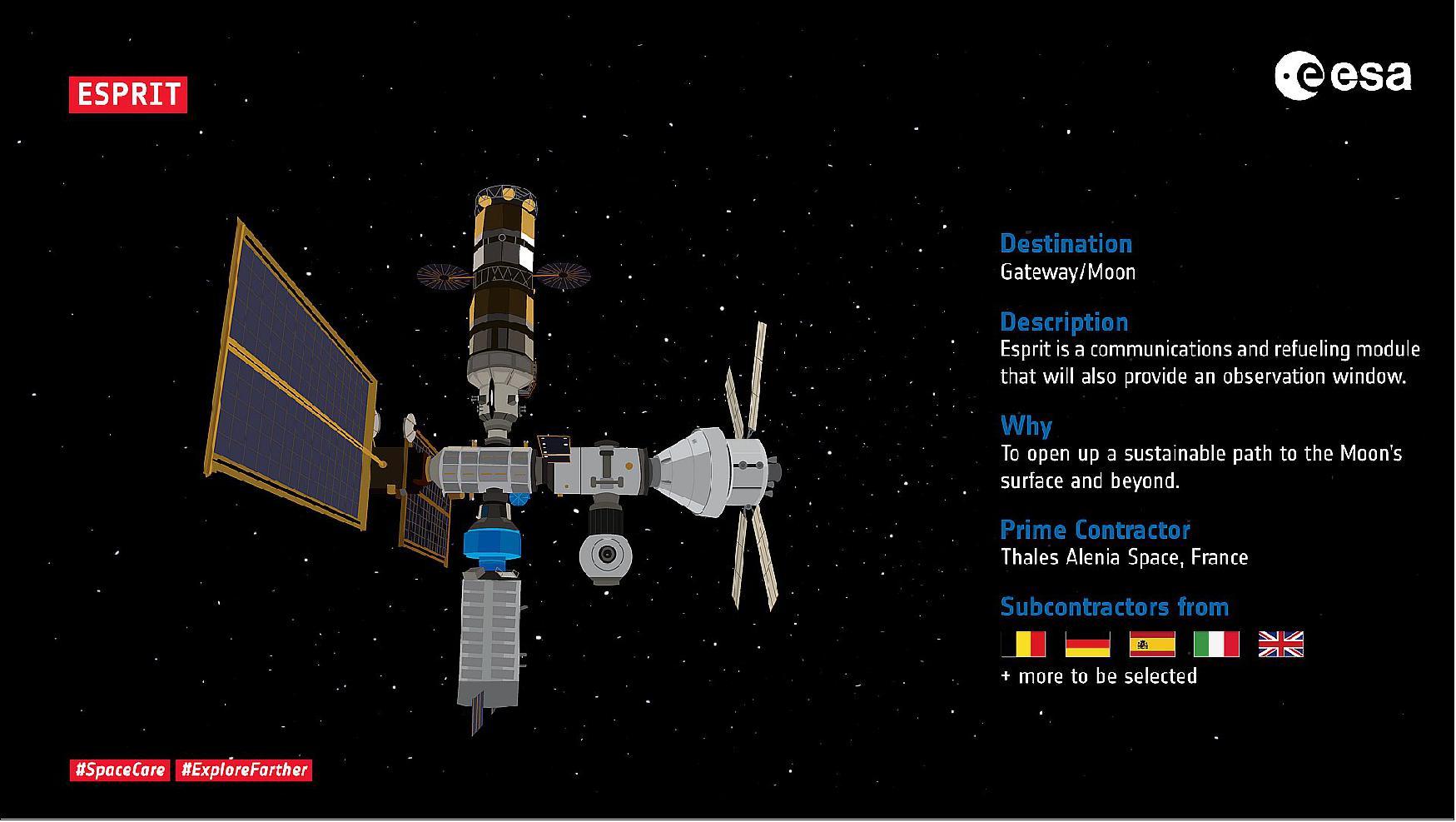
Station to Gateway
- The Gateway is part of the Artemis program to go forward to the Moon. It builds on the exemplary collaboration between space agencies over more than two decades of flying astronauts to the International Space Station. The foundations for the ESPRIT module are based on the experience of designing, building and operating existing Space Station elements flying 400 km above Earth. Now this capability will be extended one thousand times further into space.
- "This contract further cements Thales Alenia Space as a leader in designing and building human spaceflight pressurized structures. Our team is already responsible for more than half the volume of the International Space Station and we will now be working on most of the Gateway modules, including ESA's International Habitation module and providing the primary structure for NASA's Habitation and Logistics Outpost (HALO) in partnership with Northrop Grumman. The company is also involved in the Axiom commercial space station by providing the two first modules", says Massimo Claudio Comparini, Senior Executive Vice President Observation, Exploration and Navigation at Thales Alenia Space.
- French ESA astronaut Thomas Pesquet is returning to the International Space Station later this year to live for six months in modules that form the basis for the Gateway design. He is training extensively for his second mission, called Alpha, and is excited by the prospect of future missions to the Moon.
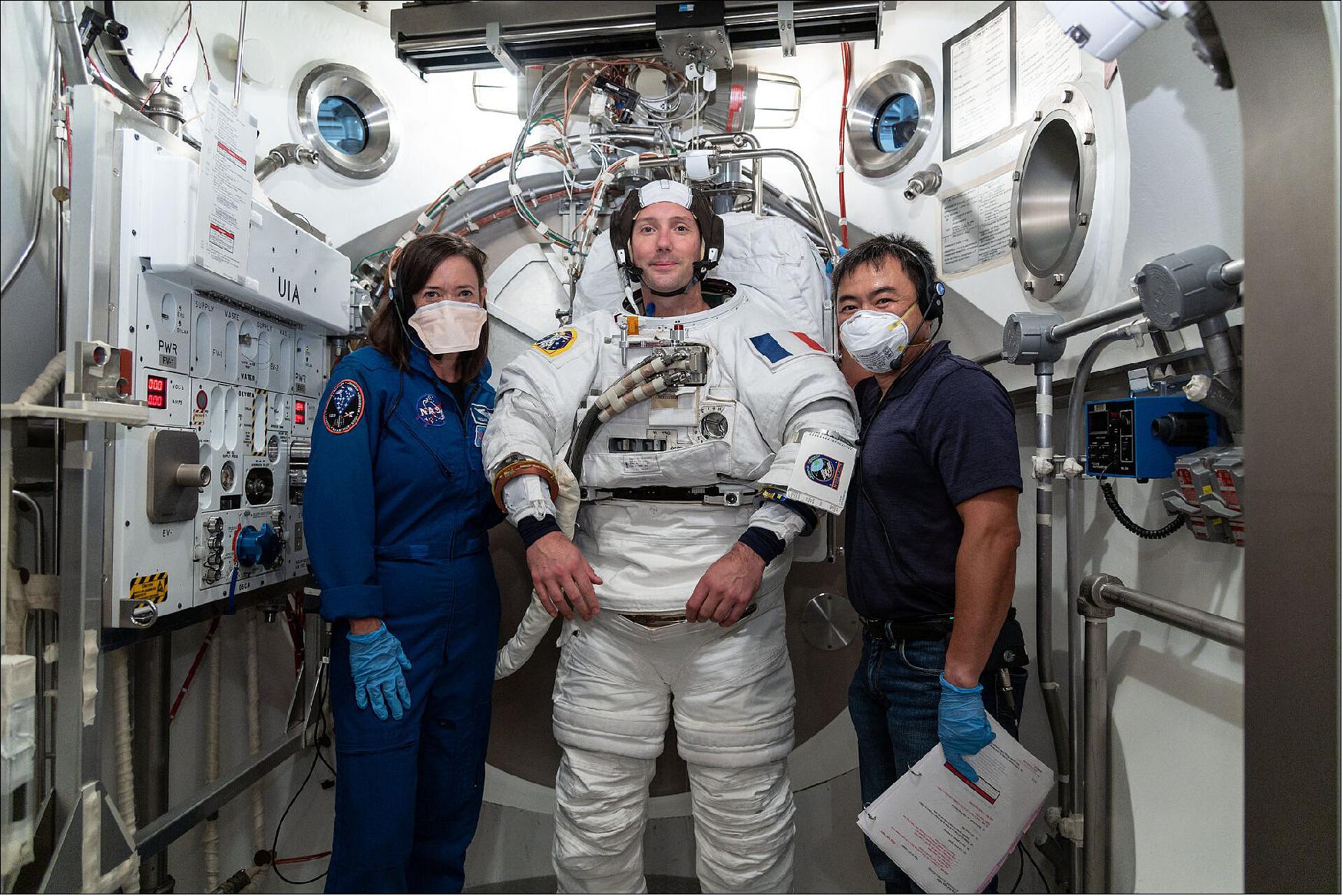
- During his upcoming Alpha mission, Thomas will continue research and experimentation on the International Space Station supported by his crewmates and ground teams from ESA, the US space agency NASA, Russian space agency Roscosmos, the Canadian Space Agency and the Japanese space agency JAXA.
- "I am thrilled that Europe is on a direct track for the Moon, and I am happy that France capitalizes on its expertise to build critical hardware! With ESA having secured participation of European astronauts on three flights to the Gateway, I hope that in the not-too-distant future I will be one of them, working with the ESPRIT module and using its hardware to communicate with the Moon. The foundations for this are being built right now in Cannes, where I was an engineering intern at the very beginning of my career! "
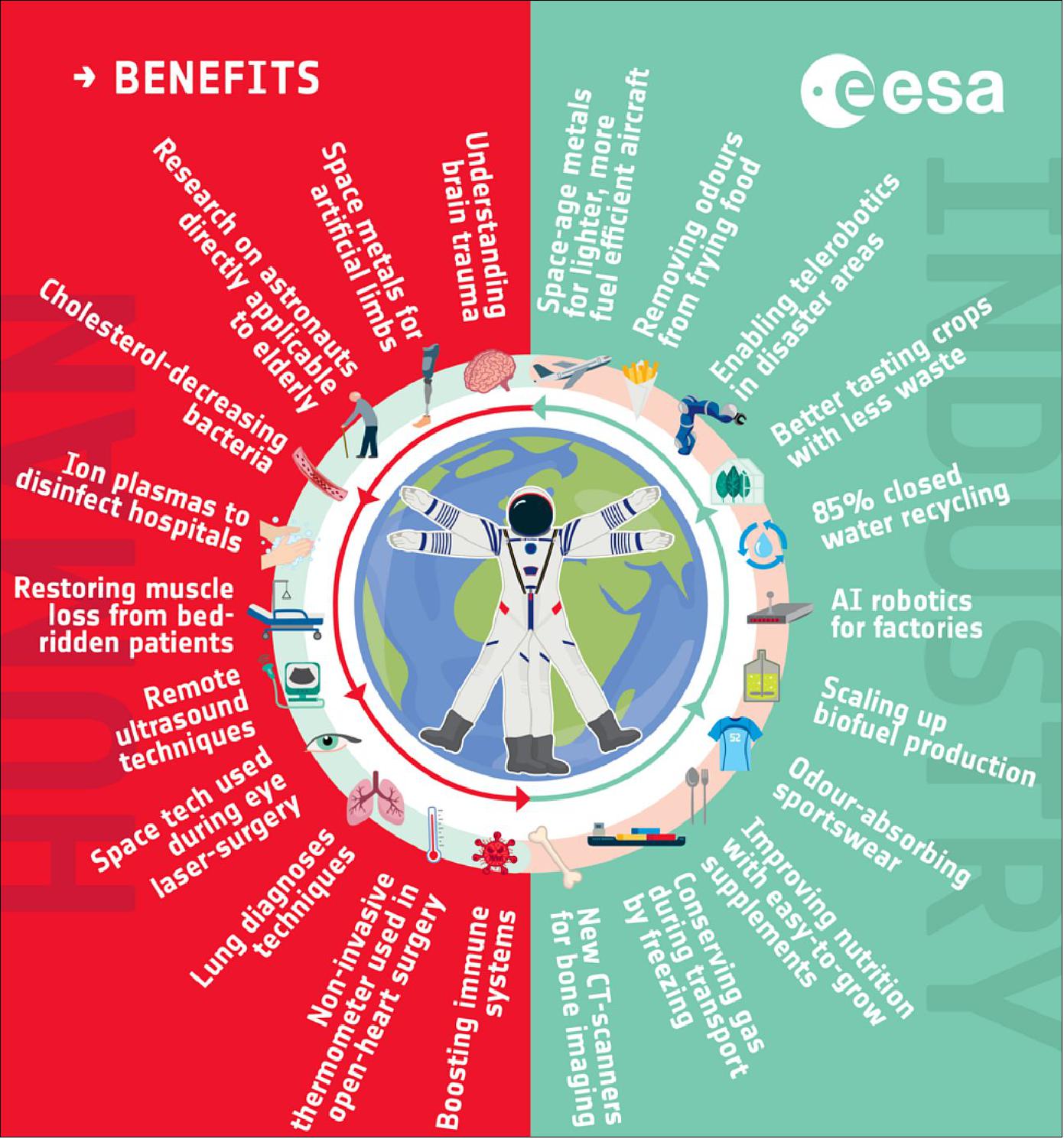
• December 16, 2020: NASA and the Canadian Space Agency (CSA) finalized an agreement between the United States and Canada to collaborate on the Gateway, an outpost orbiting the Moon that will provide vital support for a sustainable, long-term return of astronauts to the lunar surface as part of NASA's Artemis program. This Gateway agreement further solidifies the broad effort by the United States to engage international partners in sustainable lunar exploration as part of the Artemis program and to demonstrate technologies needed for human missions to Mars. 14)
- Under this agreement, CSA will provide the Gateway's external robotics system, including a next-generation robotic arm, known as Canadarm3. CSA also will provide robotic interfaces for Gateway modules, which will enable payload installation including that of the first two scientific instruments aboard the Gateway. The agreement also marks NASA's commitment to provide two crew opportunities for Canadian astronauts on Artemis missions, one to the Gateway and one on Artemis II.
- "Canada was the first international partner to commit to advancing the Gateway in early 2019, they signed the Artemis Accords in October, and now we're excited to formalize this partnership for lunar exploration," said NASA Administrator Jim Bridenstine. "This agreement represents an evolution of our cooperation with CSA providing the next generation of robotics that have supported decades of missions in space on the space shuttle and International Space Station, and now, for Artemis."
- CSA will be responsible for end-to-end external robotics, including engineering and operations. Canadarm3 will move end-over-end to reach many parts of the Gateway's exterior, where its anchoring "hand" will plug into specially designed interfaces. Delivery to the lunar outpost is targeted in 2026 via a U.S. commercial logistics supply flight.
- "Gateway will enable a robust, sustainable, and eventually permanent human presence on the lunar surface where we can prove out many of the skills, operations, and technologies that will be key for future human Mars missions," said Kathy Lueders, NASA's associate administrator for human exploration and operations.
- Approximately one-sixth the size of the International Space Station, the Gateway will function as a way station located tens of thousands of miles at its farthest distance from the lunar surface, in a near-rectilinear halo orbit. From this lunar vantage, NASA and its international and commercial partners will conduct unprecedented deep space science and technology investigations. It will serve as a rendezvous point for astronauts traveling to lunar orbit aboard NASA's Orion spacecraft and Space Launch System rocket prior to transit to low-lunar orbit and the surface of the Moon.
- "CSA's advanced robotics contribution with Canadarm3 builds upon our long spaceflight history together, enabling us to perform critical long-term sustainability and maintainability functions, overall inspections of the external Gateway and its attached vehicles, and servicing of external payloads in support of our worldwide research initiatives," said Dan Hartman, Gateway program manager at NASA's Johnson Space Center in Houston. "Our efforts are well underway on Gateway to integrate CSA's robotics system with arm attachment points and smaller dexterous adaptors already being incorporated into the individual Gateway modules including the PPE (power and propulsion element), HALO (Habitation and Logistics Outpost), Gateway logistics, and international habitation element designs."
- NASA astronauts will board a commercially developed lander for the final leg of the journey to the lunar surface, and the agency has contracted with U.S. industry to develop the first two Gateway components, PPE and HALO, as well as logistics resupply for Gateway.
- In October, NASA and ESA (European Space Agency) signed an agreement solidifying ESA's contributions to the Gateway to provide habitation and refueling modules, along with enhanced lunar communications and service modules for Orion. In March, NASA selected the first two scientific investigations to fly aboard the Gateway, one from NASA and the other from ESA. ESA developed the European Radiation Sensors Array (ERSA), and NASA's Goddard Space Flight Center is building the Heliophysics Environmental and Radiation Measurement Experiment Suite (HERMES). The two mini space weather stations will split the work, with ERSA monitoring space radiation at higher energies with a focus on astronaut protection, while HERMES monitors lower energies critical to scientific investigations of the Sun. All of the Gateway's international partners will collaborate to share the scientific data that will be transmitted to Earth. Additional scientific cooperative payloads will be selected to fly aboard the outpost.
- In addition to supporting lunar surface missions, the Gateway will support activities that will test technologies needed for human missions to Mars. Using the Gateway, NASA will demonstrate remote management and long-term reliability of autonomous spacecraft systems and other technologies.
• October 27, 2020: ESA Director General Jan Wörner and NASA Administrator Jim Bridenstine have signed a Memorandum of Understanding (MoU) to take Europe to the Moon. 15)
- The historic agreement will see ESA Member States contribute a number of essential elements to the first human outpost in lunar orbit, known as the Gateway.
- It confirms ESA's commitment to delivering at least two European Service Modules that provide electricity, water, oxygen and nitrogen to NASA's Orion spacecraft – with more to come. ESA will also receive three flight opportunities for European astronauts to travel to and work on the Gateway.
- The Gateway will enable sustainable exploration around – and on – the Moon, while enabling research and demonstrating the technologies and processes necessary to conduct a future mission to Mars. ESA's contribution to this international endeavor under the MoU includes building the main habitat for astronauts when they visit the Gateway, known as I-HAB (International Habitation) module.
- A second contribution called ESPRIT, will supply enhanced communications, refuelling capability and a window, similar to the European-built Cupola observatory on the International Space Station. This is consistent with what was approved by Member States at ESA's Space19+ Ministerial Council, in Seville, Spain, last year.
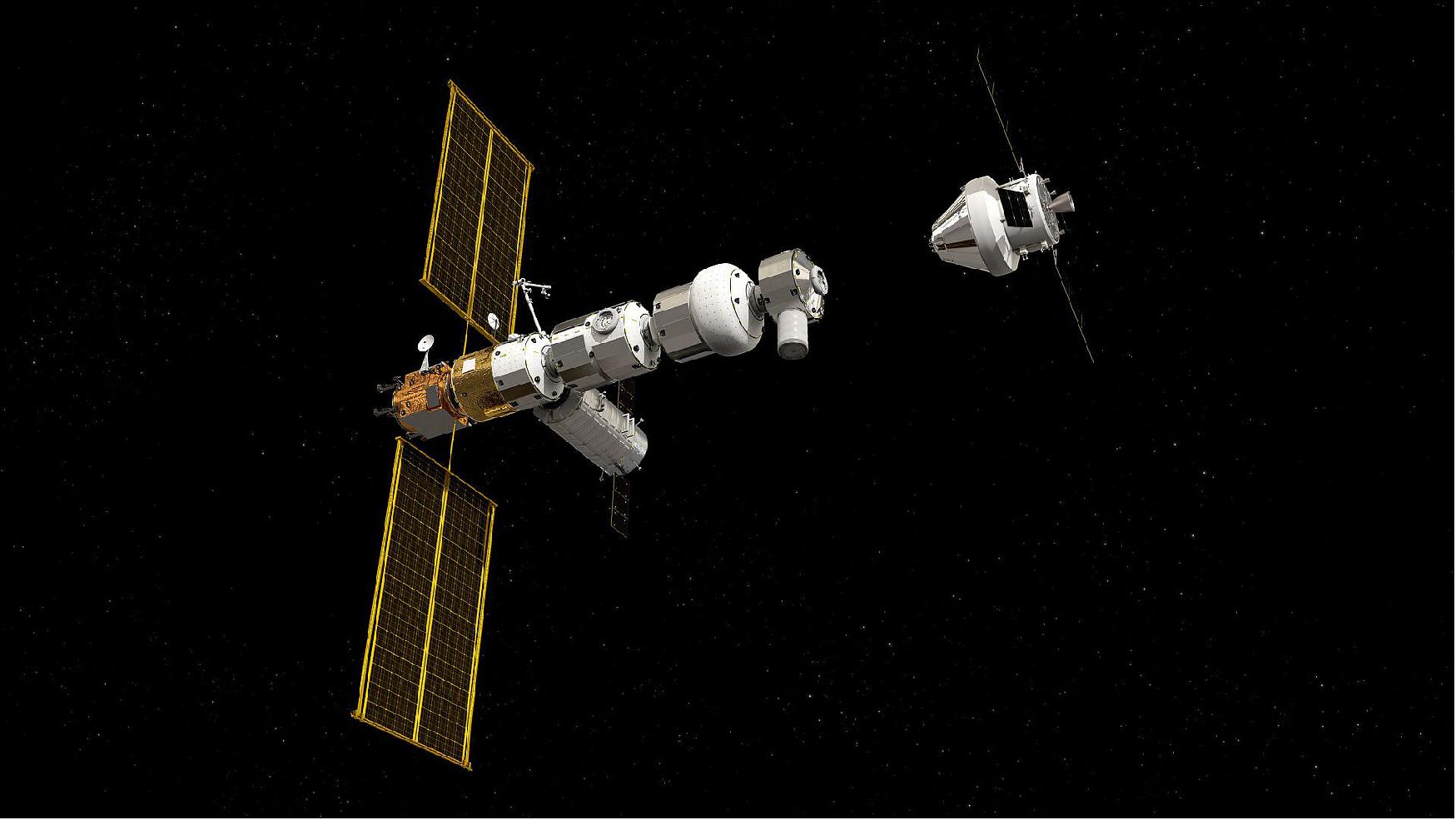
- During the 2020s, the Gateway will be assembled and operated in the vicinity of the Moon, where it will move between different orbits and enable the most distant human space missions ever attempted.
- Placed farther from Earth than the current Space Station the gateway will offer a staging post for missions to the Moon and Mars. Its flight path is a highly-elliptical orbit around the Moon – bringing it both relatively close to the Moon's surface but also far away making it easier to pick up astronauts and supplies from Earth – around a five-day trip.
- Like a mountain refuge, it will provide shelter and a place to stock up on supplies for astronauts en route to more distant destinations. It will also offer a place to relay communications and can act as a base for scientific research.
- The Gateway will have a mass of around 40 tons and will consist of a service module, a communications module, a connecting module, an airlock for spacewalks, a place for the astronauts to live and an operations station to command the gateway's robotic arm or rovers on the Moon. Astronauts will be able to occupy it for up to 90 days at a time.
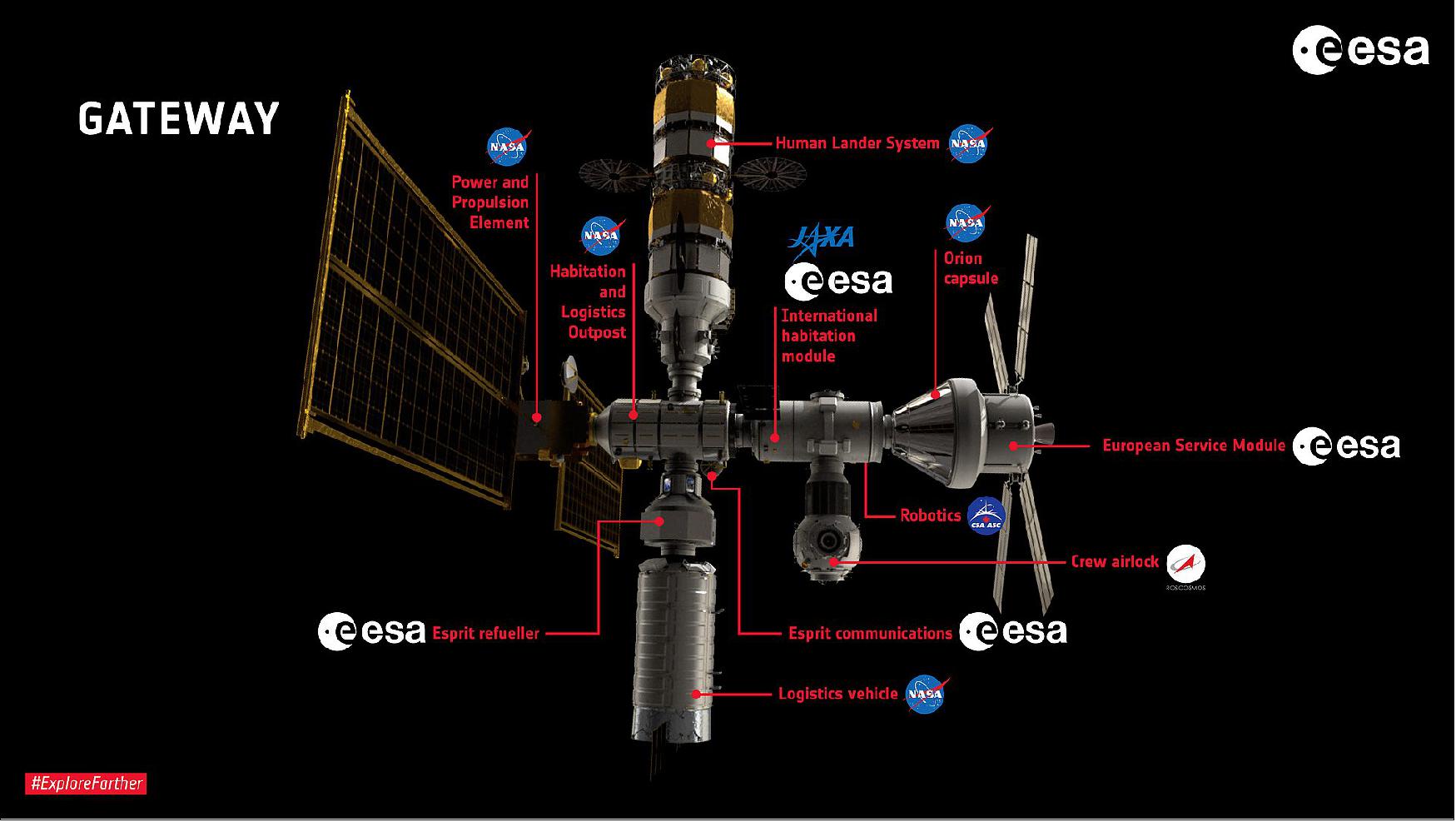
- A staging outpost near the Moon offers many advantages for space agencies. Most current rockets do not have the power to reach our satellite in one go but could reach the space gateway. Europe's Ariane would be able to deliver supplies for astronauts to collect and use for further missions deeper into space – much like mountain expeditions can stock up refuges with food and equipment for further climbs to the summit.
- The Gateway also allows space agencies to test technologies such as electric propulsion where Earth's gravity would interfere if done closer to home. New opportunities for space research away from Earth's magnetic field and atmosphere are planned for the outpost. Its close position will provide rapid response times for astronauts controlling rovers on the Moon.
• October 14, 2020: Thales Alenia Space of Turin Italy will develop two key modules for the upcoming Lunar Orbital Platform–Gateway (LOP-G): I-HAB (International Habitat) and the ESPRIT communications and refueling module. These two modules are the European contribution for this Gateway. The first tranche of I-HAB contract, (worth 36 million euros, the global amount being 327 million euros), has been signed with the European Space Agency (ESA), while ESPRIT development has already started under Authorization To Proceed (ATP) with a contract signature expected by the end of the year. 16)
- This Gateway, a manned lunar orbital infrastructure, is one of the pillars of NASA's Artemis program, designed to return humans to the Moon by 2024. It is being implemented through international cooperation, currently involving NASA (United States), ESA (Europe), JAXA (Japan) and CSA (Canada) with each partner in charge of the development of complementary elements, to be assembled and operated in lunar orbit as from 2024. The station, weighing about 40 metric tons, will be automatically assembled piece by piece in a near rectilinear halo orbit (NRHO) around the Moon. The final configuration is still partly under final consolidation, but it will mainly comprise habitation modules for the crew offering as well docking capabilities for visiting vehicles and the Orion space capsule, logistics modules, communications with the Earth and Moon, EVA airlocks for scientific experiments and crew extravehicular activities (EVA), as well as a robotic arm. It is not intended for permanent occupancy, but will be able to host 4-person crews for periods of one to three months. Gaining new experiences on and around the Moon will prepare NASA to send the first humans to Mars in the coming years, and the Gateway will play a vital role in this process.
Note: NRHO (Near Rectilinear Halo Orbit) is an eccentric orbit with an apogee at 70,000 km and a perigee at 3,000 km, enabling the space station to revolve around the Earth at the same speed as the Moon, so that from Earth it will be seen as a lunar halo.
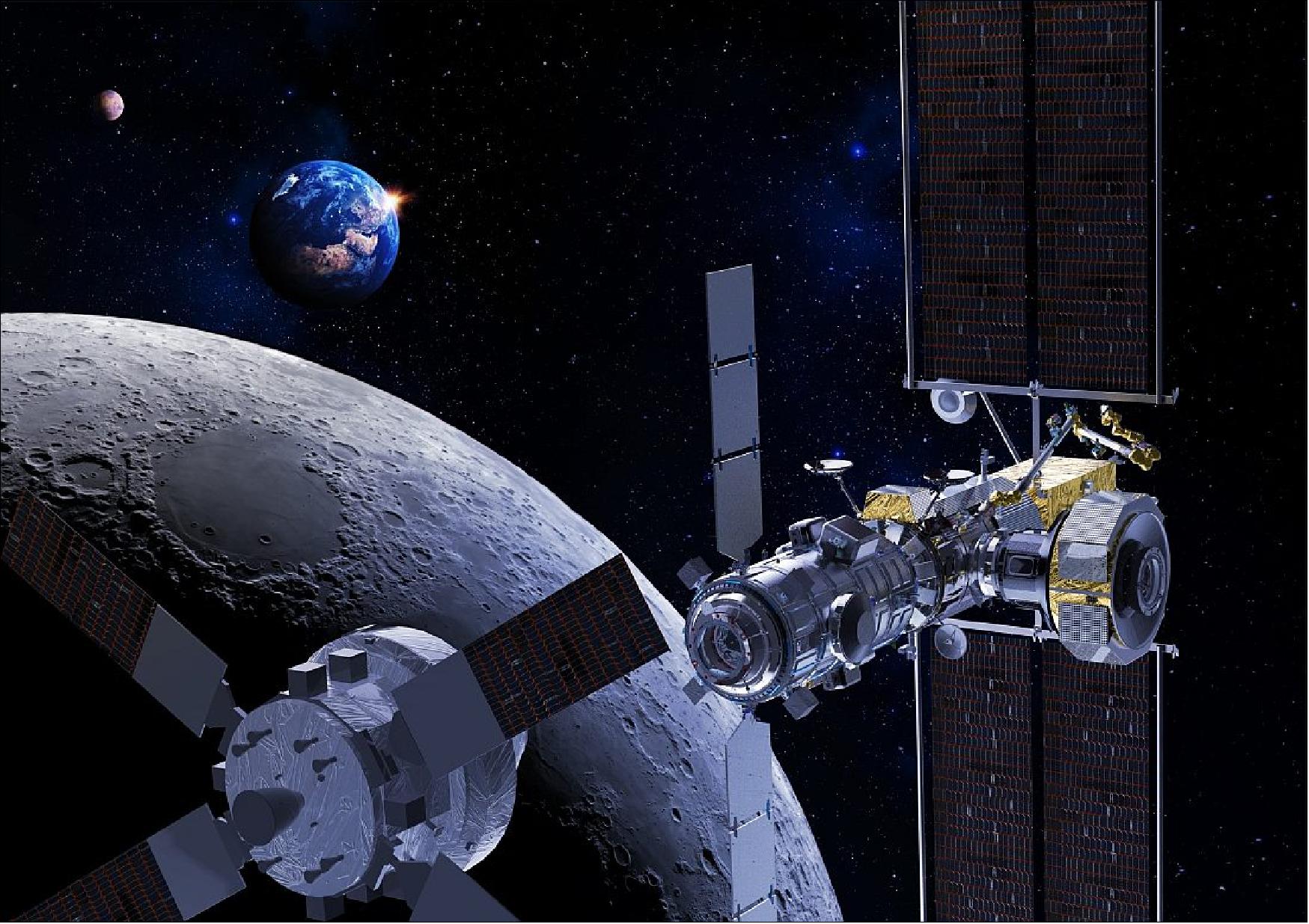
- ESA's announcement of the contracts was tied to an Oct. 14 session of the International Astronautical Congress (IAC), where ESA and European companies discussed their partnership with NASA on both the Artemis lunar exploration program and the Mars Sample Return series of missions. 17)
- The projects are funded by the contributions that ESA's member states provided to exploration programs at the Space19+ ministerial meeting last November. "This gives us new possibilities to go to low Earth orbit, the moon and Mars, and to do it together," ESA Director General Jan Wörner said at the IAC.
- Among the contracts announced were two to Thales Alenia Space for elements of the NASA-led lunar Gateway. Thales Alenia's Italian business is the prime contractor for the I-HAB, an international habitation module, while its French business will be the prime contractor for the ESPRIT (European System Providing Refueling, Infrastructure and Telecommunications), a refueling and communications module. The I-HAB contract is worth 327 million euros ($383 million). Work has started on ESPRIT under an authorization-to-proceed notice from ESA, with the contract to be finalized by the end of the year.
- "I-HAB (International Habitat) is one of the most important elements, if not the most important element, on the Gateway," said Massimo Claudio Comparini, senior executive vice president at Thales Alenia Space, in an interview. Besides providing living space for visiting crews, it will have additional docking ports for visiting vehicles.
- Thales plans to leverage its experience building modules for the International Space Station and for Northrop Grumman's Cygnus cargo spacecraft for the Gateway, but with some modifications. "The lunar environment is different from low Earth orbit," he said, requiring improved micrometeoroid shielding and radiation protection. There will also be greater emphasis on autonomous and remote operations, since unlike the ISS, the Gateway will have crews on board only occasionally.
- I-HAB , a pressurized module that will provide crew living quarters, plus docking points to supply interfaces and resources to vehicles in transit. Drawing on Thales Alenia Space's long-standing expertise in the development of pressurized modules for the ISS, along with new technologies and processes, I-HAB will mark the transition from the ISS to a new generation of space infrastructures for deep space exploration. It will meet evolving requirements and performances for lighter structures and optimized micrometeorites protection system, evolved docking systems and hatches, enhanced functional and avionic architectures, more efficient thermal control system with deployable radiators to ensure full autonomous capability of heat rejection, innovative conditioning systems. The I-HAB will experience for the first time long exposure in the deep space environment, offering the opportunity to test and prove potential design solutions for protection against cosmic radiations. Being unmanned for most of its time on orbit, it will also require dedicated solutions for the robotic operations, either on board and externally. One of the key evolving step with respect to the ISS will be focused on designing, with the support of virtual reality technique, more comfortable internal accommodations, with exploitation of modular and reconfigurable solutions to optimize room and comfort for the crew. The module will be provided by Europe with contributions from the other space Agencies like environmental and life support system from JAXA, avionics and software parts from NASA and robotic components from CSA; the integration of all these elements in I-HAB will leverage on the large experience already acquired by Thales Alenia Space during the ISS Nodes 2 and 3 activities already developed in cooperation. I-HAB is slated for launch in 2026 (Ref. 16).
- ESPRIT (European System Providing Refueling, Infrastructure and Telecommunications) consists in 2 two main elements. The first, named HLCS (Halo Lunar Communication System), ensures the communications between the Gateway and the Moon. Launch is planned 2024 with HALO, the first habitation and logistics module, supplied by the United States, and derived from the Cygnus resupply cargo, for which Thales Alenia Space has been selected to provide its primary structure and micrometeoroid protection system. ESPRIT includes a second part named ERM (ESPRIT Refueling Module) which combines the refueling of the Gateway with a small pressurized module with windows. ERM will provide active refueling of the Gateway with xenon and chemical propellants to extend its life time but also prepare for re-usable Lunar Lander or Deep Space Transport (to Mars). ERM's pressurized tunnel provides wide windows offering a 360° view on Space, Moon, Earth and on the Gateway. This pressurized volume will also contain various logistics and other elements for the crew. Delivery is planned for 2026, with launch the following year.
- Thales Alenia Space will have to meet a number of daunting challenges to design and build these two modules:
a) Technical challenges due to the severe lunar environment and extreme thermal conditions, , including protection against micrometeorites and cosmic radiation.
b) Complying with the Artemis program schedule, as well as with stringent launch weight to be compatible with a US commercial launcher.
c) Autonomous operation: since the lunar space station will not be permanently occupied, unlike the ISS, it will have to be able to function independently. Thales Alenia Space will provide robotic interfaces for both modules, I-HAB and ESPRIT, enabling remote operation and maintenance.
More About I-HAB and ESPRIT Industrial Contributions
- I-HAB: Thales Alenia Space in Italy is program prime contractor, with responsibility for overall program management, product assurance and safety, system engineering, functional design, all components concerning human factors, thermal and mechanical systems, the primary structure and production of hatches, and the assembly, integration and testing (AIT) phase. Thales Alenia Space in France is in charge of software and avionics subsystems.
- ESPRIT: Thales Alenia Space in France is program prime contractor, with Thales Alenia Space in Italy in charge of the pressurized tunnel and windows. Thales Alenia Space in the UK will contribute to the chemical refueling system, while OHB (as part of the core team) will be in charge of mechanical and thermal subsystems for the non-pressurized sections and the xenon refueling system. Selected in open competition, Thales Alenia Space in Belgium will provide the HLCS electrical Interfaces units (Remote Interface & Distribution Unit – RIDU) and the radio frequency amplifiers (TWTAs), Thales Alenia Space in Spain the S-band communication transponder and Thales Alenia Space in Italy for the K-band transceiver.
- About Artemis: moving forward to the Moon in 2024! The Artemis program will proceed in three phases: Artemis 1, a non-crewed flight to test the launch system and the Orion spacecraft together; Artemis 2, a first crewed flight of Orion; and Artemis 3, to land astronauts on the Moon as from 2024. The program will set up sustainable structures on the Moon and in lunar orbit to carry out further human exploration of the surface and various scientific investigations. The Gateway will be a key to this program: it will be used as an outpost for astronauts on their way to the Moon, and as a laboratory to carry out scientific research, and thus support the development of sustained Moon exploration by the end of the decade. As from 2024, astronauts will have two options: lift off from the Earth and land directly on the Moon; or dock their Orion space capsule to the station, then rocket down to the Moon.
About Thales Alenia Space Involvement in the Moving Forward to the Moon Challenge
- Already providing the thermo-mechanical systems for Orion European Service Module as well as the European Space Agency contribution in the Gateway with ESPRIT and I-HAB, Thales Alenia Space is also involved in NASA's Human Landing System (HLS) initiative, as part of the Dynetics-led consortium recently chosen by NASA as well as in VIPER, the rover that NASA will send to the South Pole of the Moon in search for water. Moreover, Thales Alenia Space has been appointed by the European Space Agency, partnering with OHB Germany, for the engineering and feasibility study of the European Large Logistic Lander (EL3), envisioned as a versatile system that can support a variety of cargo delivery and science missions on the Lunar surface, in the frame of the ARTEMIS program.
• March 30, 2020: NASA has selected SpaceX of Hawthorne, California, as the first U.S. commercial provider under the Gateway Logistics Services contract to deliver cargo, experiments and other supplies to the agency's Gateway in lunar orbit. The award is a significant step forward for NASA's Artemis program that will land the first woman and next man on the Moon by 2024 and build a sustainable human lunar presence. 18) 19)
- At the Moon, NASA and its partners will gain the experience necessary to mount a historic human mission to Mars.
- SpaceX will deliver critical pressurized and unpressurized cargo, science experiments and supplies to the Gateway, such as sample collection materials and other items the crew may need on the Gateway and during their expeditions on the lunar surface.
- "This contract award is another critical piece of our plan to return to the Moon sustainably," said NASA Administrator Jim Bridenstine. "The Gateway is the cornerstone of the long-term Artemis architecture and this deep space commercial cargo capability integrates yet another American industry partner into our plans for human exploration at the Moon in preparation for a future mission to Mars."
- NASA is planning multiple supply missions in which the cargo spacecraft will stay at the Gateway for six to 12 months at a time. These firm-fixed price, indefinite delivery/indefinite quantity contracts for logistics services guarantee two missions per logistics services provider with a maximum total value of $7 billion across all contracts as additional missions are needed.
- "Returning to the Moon and supporting future space exploration requires affordable delivery of significant amounts of cargo," said SpaceX President and Chief Operating Officer Gwynne Shotwell. "Through our partnership with NASA, SpaceX has been delivering scientific research and critical supplies to the International Space Station since 2012, and we are honored to continue the work beyond Earth's orbit and carry Artemis cargo to Gateway."
- NASA issued a call for proposals for the Gateway Logistics Services program in August. Companies had to propose spacecraft capable of carrying at least 3,400 kg of pressurized cargo and 1,000 kg of unpressurized cargo to the Gateway, and be able to dispose of at least as much cargo from the Gateway. Proposals were due in October and NASA originally expected to make awards by the end of 2019. The agency didn't disclose the reason for the nearly three-month delay.
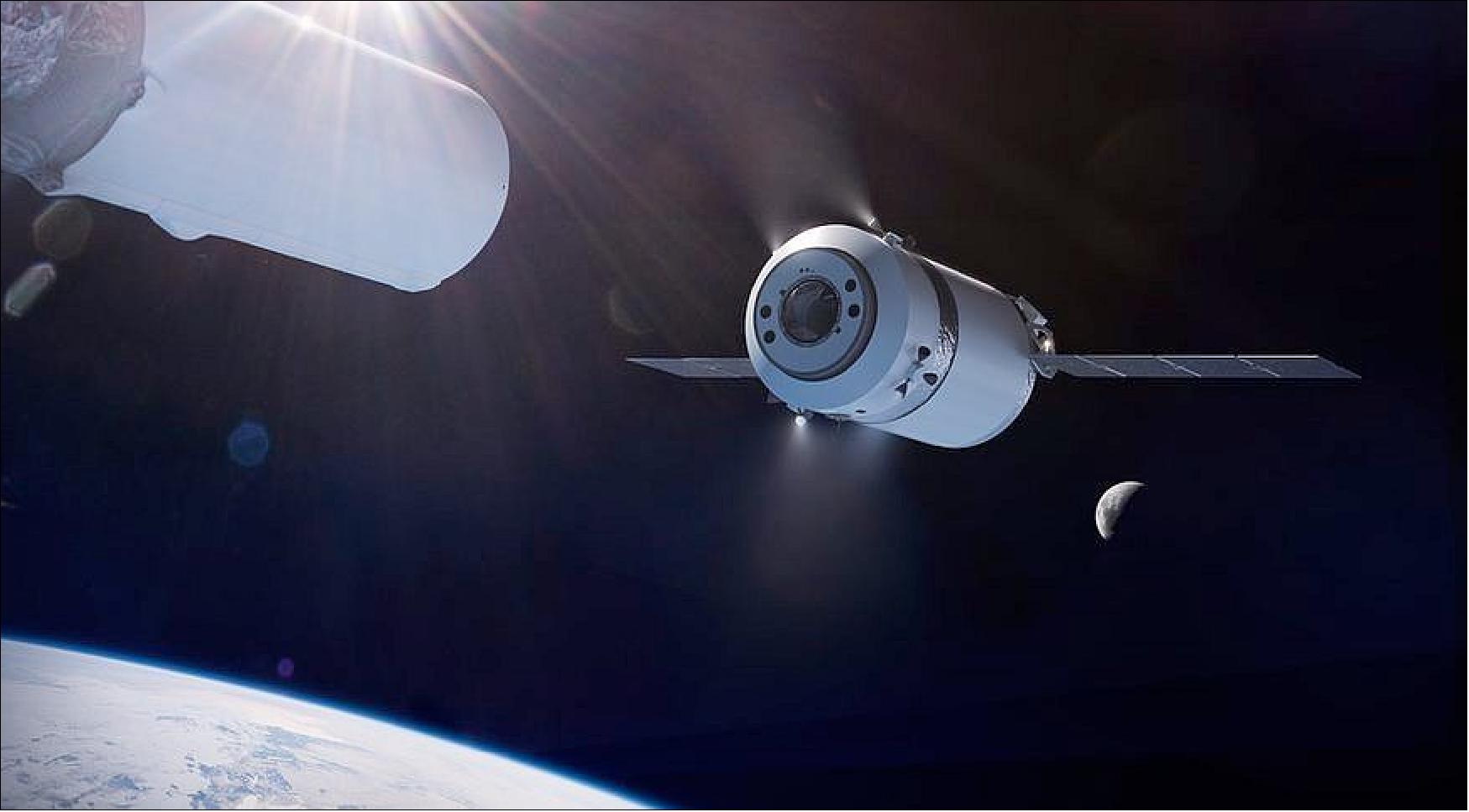
- Each mission will remain docked to the station for up to a year and could provide additional volume for crews there. "Bringing a logistics provider onboard ensures we can transport all the critical supplies we need for the Gateway and on the lunar surface to do research and technology demonstrations in space that we can't do anywhere else. We also anticipate performing a variety of research on and within the logistics module," said Dan Hartman, the Gateway program manager NASA's Johnson Space Center, in the statement.
- The Gateway Logistics Services contract enables NASA to order missions for as long as 12 years with a 15-year performance period and provides the ability to add new competitive providers.
- These missions will support NASA's plans for sustainable exploration with both international and commercial partners, while developing the experience and capabilities necessary to send humans to Mars.
- "This is an exciting new chapter for human exploration," said Mark Wiese, Deep Space Logistics manager at NASA's Kennedy Space Center in Florida. "We are bringing the innovative thinking of commercial industry into our supply chain and helping ensure we're able to support crews preparing for lunar surface expeditions by delivering the supplies they need ahead of time."
- Charged with returning to the Moon in the next four years, NASA's Artemis program will reveal new knowledge about the Moon, Earth and our origins in the solar system. The Gateway is a vital part of NASA's deep space exploration plans, along with the Space Launch System (SLS) rocket, Orion spacecraft, and human landing system that will send astronauts the Moon.
- One standard logistics service mission is anticipated for each Artemis SLS/Orion crewed mission to the Gateway. Gaining new experiences on and around the Moon will prepare NASA to send the first humans to Mars in the coming years, and the Gateway will play a vital role in this process.
- "We're making significant progress moving from our concept of the Gateway to reality," said Dan Hartman, Gateway program manager at NASA's Johnson Space Center in Houston.
- "Bringing a logistics provider onboard ensures we can transport all the critical supplies we need for the Gateway and on the lunar surface to do research and technology demonstrations in space that we can't do anywhere else. We also anticipate performing a variety of research on and within the logistics module."
• March 13, 2020: The first science experiments that will be hosted on the Gateway, an international outpost which will orbit the Moon, have been selected by ESA and NASA. Europe's contribution will monitor radiation to gain a complete understanding of cosmic and solar rays in unexplored areas as the orbital outpost is assembled around the Moon. 20)
- The first module for the Gateway, the Power and Propulsion Element, is set to host two external scientific investigations.
- ESA's hardware will actively monitor radiation at all times and return data for scientists from participating countries to consult.
- As the Gateway module flies to its position in a halo-like orbit around the Moon, it will pass through the Van Allen radiation belt – an area around Earth where high-energy particles are trapped by our planet's magnetic field. The particles can cause more radiation damage to humans, and the hardware will provide useful information on to how to keep astronauts safe as they pass through the belt.
- Once in position, the Gateway will orbit the Moon flying as close as 3,000 km from the lunar surface and at its furthest, 70,000 km. The radiation investigation will continue to monitor the changes in protons, electrons and heavy ions and neutrons as they hit the measuring instruments.
- Mission planners at NASA and ESA's Space Operations Center (ESOC) have spent months debating the pros and cons of different orbits, and have now decided on the path of the lunar Gateway – a ‘near-rectilinear halo orbit', or NRHO. — Instead of orbiting around the Moon in a low lunar orbit like Apollo, the Gateway will follow a highly ‘eccentric' path. At is closest, it will pass 3,000 thousand km from the lunar surface and at its furthest, at 70,000 km. The orbit will actually rotate together with the moon, and as seen from the Earth will appear a little like a lunar halo.
Heavy Interactions in Space
- "Heavy neutrons are of particular interest for us," says ESA's Science Team Leader of Human and Robotic Exploration Jennifer Ngo-Anh "some cosmic rays hit the Moon and interact with the surface to reflect as heavy neutrons that are particularly damaging to humans. We need to know more about where and how these particles form, to protect astronauts."
- NASA's first investigation to fly aboard the Gateway is a Sun-oriented space weather experiment to observe solar particles and solar wind. Large explosions on the Sun are unpredictable and can result in violent outbursts of radiation and energetic solar wind that could hit astronauts as they venture outside the protective atmosphere of Earth.
- "Both these experiments will work together to supply much-needed information to forecast radiation events and how to build better spacecraft and protection for astronauts on and around the Moon," explains ESA's director of Human and Robotic Exploration David Parker.
- "As we prepare for the next generation of European astronauts who will join their NASA colleagues in the Artemis program, this research is of vital importance and shows how science and exploration go hand-in-hand as we move forward to the Moon."
- More science will be selected to fly aboard the Gateway in the future to take advantage of the unique environment in lunar orbit that cannot be duplicated on Earth or on the International Space Station.
- The Gateway will be built and assembled this decade as a platform for exploration, science, and commercial activities in deep space. Gateway operations will provide invaluable experience and demonstrate critical technologies in support of a future human mission to Mars. Following decisions at Space19+, ESA will build a Habitation module, communications systems and a refuelling module for the Gateway. The Canadian Space Agency (CSA) has committed to provide advanced robotics for the lunar outpost. The Japanese Aerospace Exploration Agency is also in discussion to supply elements.
• March 9, 2020: Humankind's next space outpost, the lunar Gateway, will serve as a staging point to reach the surface of the Moon. A new ESA-backed study is considering whether it could also be used as a deployment point for planetary defense missions, to intercept asteroids approaching dangerously close to Earth. 21)

- Set for assembly over the course of this decade, the Gateway will be placed in a highly elongated, or ‘eccentric' week-long orbit around the Moon, passing a minimum 3,000 km from the lunar surface and 70,000 km at its furthest away. Crewed missions will require much less energy to rendezvous with the Gateway than to fly direct to the surface of the Moon, and could then venture down using Gateway-based landers.
- But the Gateway could also support operations into deep space – including spacecraft for planetary defense, to deflect the orbital paths of incoming asteroids.
- The concept might sound like science fiction, but Earth's first planetary defense missions are already in active preparation. NASA's Double Asteroid Redirect Test (DART) spacecraft, due to launch next year, will impact the smaller of the Didymos asteroid pair, in orbit between Earth and Mars, in a bid to shift its orbit. In 2026 ESA's Hera spacecraft will perform a close-up survey of the asteroid post-impact.
- The DART and Hera missions, known jointly as the Asteroid Impact and Deflection Assessment (AIDA) collaboration represent an experimental trial-run on a distant body that poses no threat to Earth. Once proven, the deflection technique could be used for real on asteroids coming dangerously close – but a rapid reaction time would be crucial for maximum effectiveness.
- Accordingly ESA is funding a new study by Politechnico di Milano to analyze options for using the Gateway to park planetary defense spacecraft in readiness to intercept incoming asteroids. These spacecraft would be able to depart the Gateway with much lower energies compared with departing from Earth itself.
- "This promising study comes out of one of the latest ideas received through ESA's Open Space Innovation Platform, OSIP," explains Moritz Fontaine, the Agency's Discovery and Preparation Officer. "Using OSIP, anyone is welcome to propose novel ideas to address space-related challenges.
- "We channel the most promising ideas through appropriate ESA implementation paths. Ideas can come from anyone: specialist researchers, companies or members of the public. Although OSIP was launched less than a year ago, we have already received hundreds of proposals."
- Other OSIP-submitted research ideas selected for funding in January 2020 include:
a) New ways of building satellites might be creating a new type of space debris: the latest carbon fibre reinforced plastics, when broken apart, could be giving rise to vast amounts of tiny fragments of carbon fibres. These are not represented in current debris models, so a dedicated model needs to be made.
b) Air-filled integrated waveguides could enable the design of low-cost, high performance antennas for the coming wave of satellite constellations.
c) The autonomy of embedded devices aboard satellites could be boosted using AI-based hardware accelerators.
d) With nanomaterials used increasingly for biomedical applications, investigation is needed into how weightlessness influences their effects within biological systems.
• November 1, 2019: Ambitious projects are underway in preparation for the upcoming ARTEMIS Mission challenge in 2024. Two companies, space supplier RUAG Space and high-tech company TTTech are offering high-performance data exchange electronics for Lunar Gateway modules – in time for the ARTEMIS Mission challenge in 2024. 22)
- In 2011, via a Space Act Agreement, TTTech and NASA standardized TTEthernet technology as an open industry standard i.e. SAE AS6802 together with several industry partners. This open standard has recently been ratified by NASA, ESA, CSA and JAXA as the IASIS (International Avionics System Interoperability Standards) for deep space applications.
- TTEthernet technology allows fast and reliable data transfer on the "Lunar Gateway" space station, which will orbit around the Moon and serve as the portal to the surfaces of Moon and Mars. RUAG Space will provide space qualified hardware that enables the use of this highly reliable technology in space applications. Both companies will offer these electronic products to all interested customers. TTEthernet is also used very successfully by the NASA Orion spacecraft and by the new European launcher Ariane 6 as the on-board avionics backbone network.
- Peter Guggenbach, CEO RUAG Space said that this is a perfect partnership. An electronic product that brings together the strong experience from RUAG in space hardware engineering and manufacturing with the expertise in software and ASICs from TTTech. They have invested a lot of resources into engineering and customers can trust them to bring a reliable product that is ready-to-use. With their legacy of success, they will help customers save time and meet their ambitious mission schedules. The first crewed mission i.e. ARTEMIS to the "Lunar Gateway" station and the moon is planned for 2024.
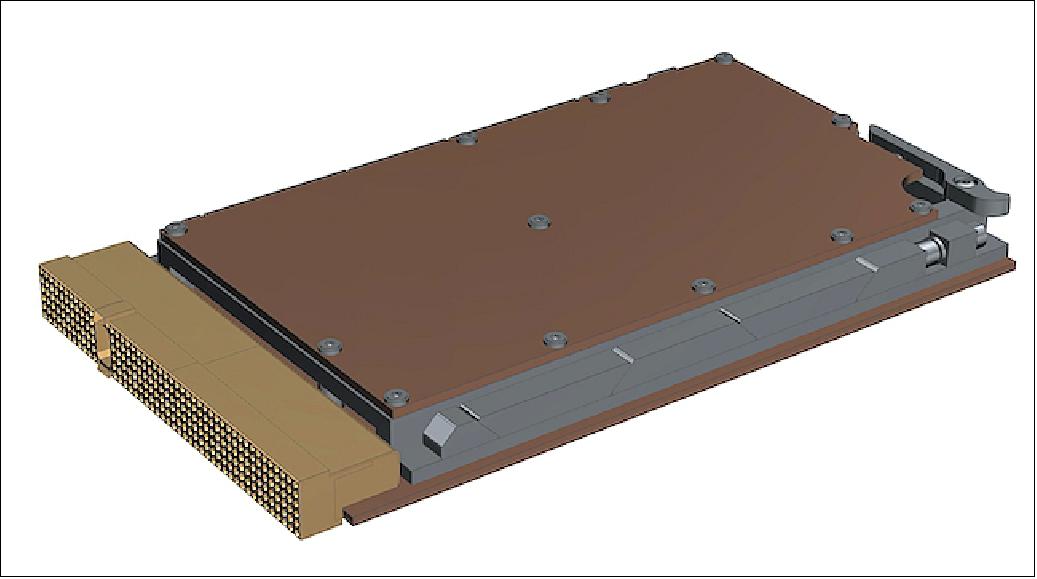
- Christian Fidi, VP Products, Sales and Marketing of TTTech's Aerospace business unit, highlights the safety and reliability of the technological solutions added that they have delivered a safety-critical standard that is proven and as yet unmatched in the industry. Customers benefit from off-the-shelf hardware solutions that perfectly serve a highly competitive and dynamic space market. Time-Triggered Ethernet is faster and more reliable than any other technology in the market.
- Time-Triggered Technology was invented by TTTech. The company describes the essence of this technology is to create networks that are fully deterministic, meaning each sender and receiver in a network knows when to send or expect a message. This brings several advantages: Not only are all failures that result in some latency in the network eliminated, it also allows to use the entire bandwidth of the links within the networks.
• August 19, 2019: The Canadian Space Agency (CSA) has awarded two contracts for external robotics interfaces in preparation for Canadarm3, Canada's contribution to the US-led Lunar Gateway. 23)
- These interfaces will permit Canadarm3 to attach and operate on the exterior of the Gateway modules.
- The first contract is awarded to MDA (MacDonald, Dettwiler and Associates), a Maxar company. The contract covers concept and technology development activities of robotics interfaces for the XLA (eXploration Large Arm).
- The second contract is also awarded to MDA, a Maxar company. The contract covers concept and technology development activities of robotics interfaces for the smaller XDA (eXxploration Dexterous Arm).
• July 18, 2019: Mission planners at NASA and ESA/ESOC (European Space Operations Center) have spent months debating the pros and cons of different orbits, and have now decided on the path of the lunar Gateway - called the angelic halo orbit or the NRHO (Near-Rectilinear Halo Orbit). 24)
- Like the International Space Station, the Gateway will be a permanent and changeable human outpost. Instead of circling our planet, however, it will orbit the Moon, acting as a base for astronauts and robots exploring the lunar surface.
- Like a mountain refuge, it will also provide shelter and a place to stock up on supplies for astronauts en route to more distant destinations, as well as providing a place to relay communications and a laboratory for scientific research.
- Mission analysis teams at ESOC are continuing to work closely with international partners to understand how this choice of orbit affects vital aspects of the mission – including landing, rendezvous with future spacecraft and contingency scenarios needed to keep people and infrastructure safe.
- Instead of orbiting around the Moon in a low lunar orbit like Apollo, the Gateway will follow a highly ‘eccentric' path. At is closest, it will pass 3,000 km from the lunar surface and at its furthest, at 70,000 km. The orbit will actually rotate together with the moon, and as seen from the Earth will appear a little like a lunar halo.
- A permanent base in this orbit around the Moon will act as a staging post, from where parts can be left behind, picked up and assembled. After liftoff, only a moderate maneuver will be needed to slow a visiting spacecraft to rendezvous with the Gateway.
- Orbits like these are possible because of the interplay between the Earth and Moon's gravitational forces. As the two large bodies dance through space, a smaller object can be ‘caught' in a variety of stable or near-stable positions in relation to the orbiting masses, also known as libration or Lagrange points.
- Such locations are perfect for planning long-term missions, and to some extent dictate the design of the spacecraft, what it can carry to and from orbit, and how much energy it needs to get – and stay – there.
- Travelling on the NRHO path, one revolution of the Gateway in its orbit about the Moon would take approximately seven days. This period was chosen to limit the number of eclipses, when the gateway would be shrouded by the Earth's or the Moon's shadow.
- "Finding a lunar orbit for the gateway is no trivial thing." says Markus Landgraf, Architecture Analyst working with ESA's Human and Robotic Exploration activities. "If you want to stay there for several years, the near rectilinear halo orbit is slightly unstable and objects in this orbit do have a tendency of drifting away". To keep the Gateway in position, regular small station-keeping maneuvers will be required.
Take the Stage
- So why this orbit? The fundamental limiting factor when moving parts from Earth, to a potential lunar base and the Moon's surface, is energy.
- "In human spaceflight we don't fly one single, monolithic spacecraft," explains Florian Renk, Mission Analyst in ESOC's Flight Dynamics Division. "Instead we fly bits and pieces, putting parts together in space and soon on the surface of the Moon. Some parts we leave behind, some we bring back – the structures are forever evolving."
- To escape Earth's gravitational pull requires a huge amount of energy. To then land on the Moon and not hurtle straight past it, we have to slow down by losing that same energy. We can save some of this energy by leaving parts of the spacecraft in orbit, taking only what we need to the surface of the Moon.
- A permanent base in this orbit around the Moon will act as a staging post, from where parts can be left behind, picked up and assembled. After liftoff, only a moderate maneuver will be needed to slow a visiting spacecraft to rendezvous with the Gateway.
- The Lunar lander will then transport people, robots and infrastructure down to the surface when the Gateway is closest to the Moon, which happens about every seven days. Likewise, a transfer window to the gateway opens about every seven days for the return trip from the lunar surface.
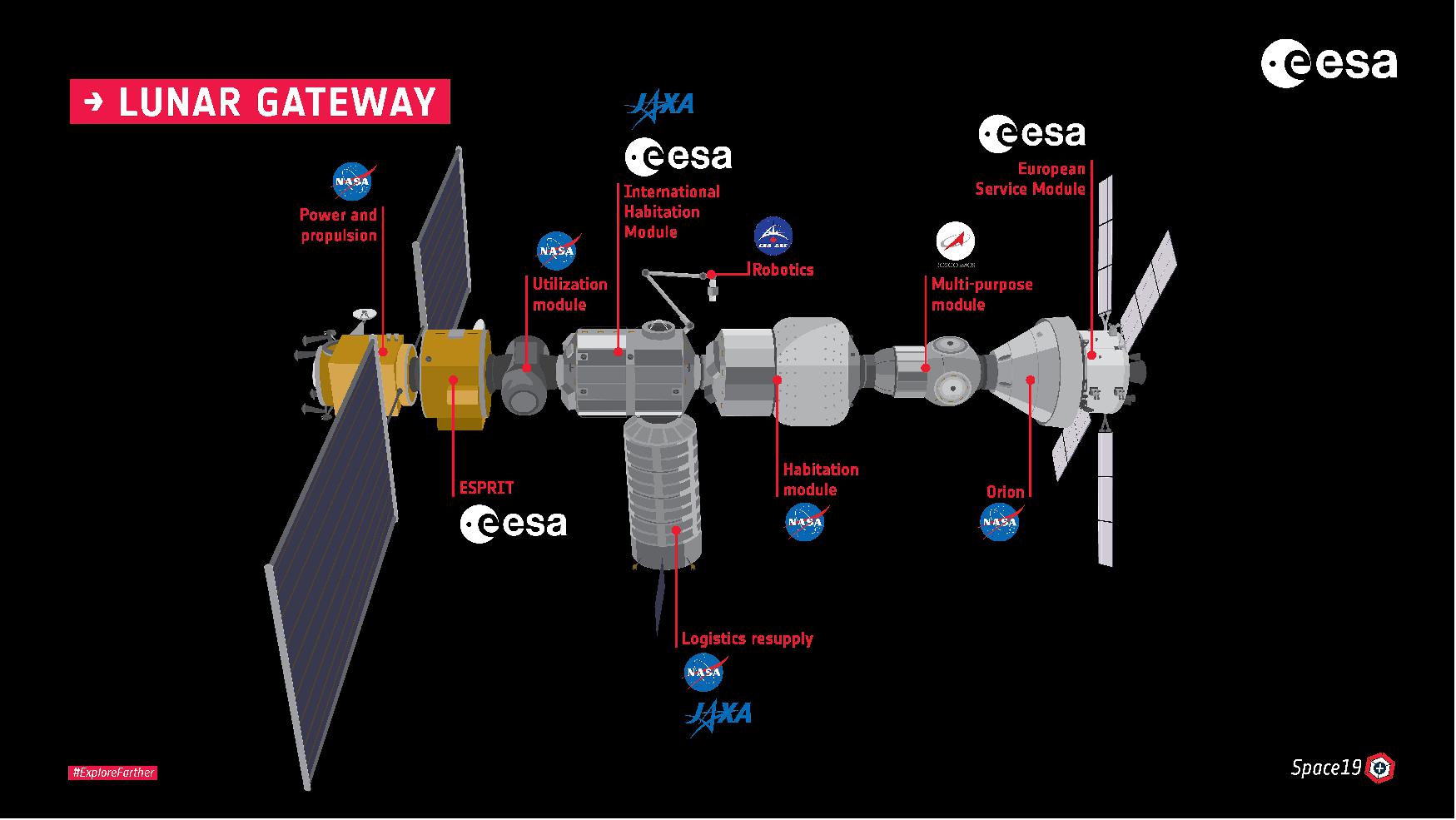
• June 14, 2019: In the latest step in sending astronauts to the lunar surface within five years, NASA issued a draft solicitation June 14 to industry seeking comments for a future opportunity for American companies to deliver cargo and other supplies to the Gateway in lunar orbit. 25)
- The first logistics service to the orbital outpost is expected to deliver science, cargo and other supplies in support of the agency's new Artemis lunar exploration program, which includes sending the first woman and the next man to the surface of the Moon by 2024.
- Last fall, NASA asked American companies for ideas on how to best supply the Gateway, which will be located in an orbit around the Moon about 250,000 miles from Earth. The Gateway will be a command and service module for missions to the lunar surface and eventually, exploration farther into the solar system. Following up on that initial request for information, today NASA published a draft solicitation for industry comments on its logistics approach, which are due July 10, 2019.
- "We're asking industry to provide a spacecraft to deliver cargo and other supplies to the Gateway. It will dock to the orbital outpost, but will be responsible for generating its own power," said Marshall Smith, director, human lunar exploration programs at NASA Headquarters in Washington. "We're using the Moon as a proving ground for Mars to develop the technologies and systems we need for exploration farther into the solar system, so we look forward to seeing how industry responds to our upcoming solicitation, and potentially awarding multiple contracts for this lunar service."
- This latest call is mirroring similar cargo resupply services the agency pioneered with industry closer to home. NASA led the way for commercialization of low-Earth orbit, and is now providing new opportunities for private companies in deep space.
- "The Gateway, and specifically our logistics supply requirements, enables the deep space supply chain, taking the next step toward further commercialization of space," said Mark Wiese, NASA's Gateway logistics element manager at Kennedy Space Center in Florida. "In addition to delivering cargo, science and other supplies to the Gateway with these services, there's potential for an extension to industry to deliver other elements of our lunar architecture with this solicitation."
- A formal solicitation for a firm-fixed price contract is expected this summer. NASA anticipates the maximum contract award for all Gateway services over the course of 15 years will be valued at $7 billion.
- NASA will host an industry day forum in Florida on June 26 to answer questions and explain the proposed approach for logistic deliveries. Additional details about that opportunity for industry are available online.
- This announcement comes on the heels of other recent agency efforts to accelerate its Moon to Mars exploration plans. At the end of May, NASA awarded a contract to Maxar Technologies to build, launch, and demonstrate in space the power and propulsion element of the Gateway. And ahead of sending astronauts to the Moon, the agency will use a series of commercial Moon deliveries to send a suite of science instruments and technology demonstrations to the surface to continue studying Earth's nearest neighbor. NASA is also working with 11 companies to study the proposed architecture for a new integrated human landing system, which would be staged at the Gateway for missions to the lunar surface.
- Charged with returning to the Moon within five years, NASA's lunar exploration plans are based on a two-phase approach: the first is focused on speed – landing on the Moon by 2024 – while the second will establish a sustained human presence on and around the Moon by 2028. The agency will use what we learn on the Moon to prepare for the next giant leap – sending astronauts to Mars.
• May 31, 2019: NASA has just announced a major step forward in its plan to send astronauts to the Moon by 2024: task order awards to three commercial partners to deliver NASA science and technology instruments to the Moon. This is one of many recent milestones to come in our new Artemis program to explore the Moon. 26)
- On April 9, NASA expressed its commitment to a timeline of landing humans on the lunar south pole by 2024, The agency's lunar exploration plans are based on a two-phased approach: the first is focused on speed – landing astronauts on the Moon in five years – while the second will establish a sustained human presence on and around the Moon by 2028. NASA will use an orbiting lunar outpost called Gateway to access the Moon. The agency is targeting launch of the power and propulsion element in late 2022.
- Planning this program requires many different pieces, including new technologies and partnerships. Developments on all fronts are moving ahead rapidly. Here's a summary of recent progress with Artemis.
A Charge Forward
- The Artemis program will send the first woman and the next man to the Moon by 2024 and develop a sustainable human presence on the Moon by 2028. The program takes its name from the twin sister of Apollo and goddess of the Moon in Greek mythology.
- Our Moon to Mars exploration approach is outlined in Space Policy Directive-1, which President Trump signed into law in December 2017. In one of the first steps to accomplish this bold goal, NASA announced its CLPS (Commercial Lunar Payload Services) initiative, in which companies under contract can bid on delivering science and technology payloads to the Moon. These public-private partnerships will be essential to the development of Artemis program by helping us study the Moon ahead of a human return.
Astronaut Health Projects Selected
- Astronauts face a very different environment in space than on Earth, and scientists are still investigating the many possible impacts of spaceflight on the human body. On April 30, NASA selected 12 proposals for projects related to studying astronaut health and performance during future long-duration missions beyond low-Earth orbit. These include what effects stress and sleep disturbances in space may have on the brain function, as well as how the immune system responds to simulated microgravity.
- The 12 projects will help prepare astronauts for what they may experience on missions to the Moon, and eventually Mars.
Budget Amendment
- Sending humans to the Moon by 2024 will require funds specifically for this endeavor. On May 13, President Trump announced a budget amendment for fiscal year 2020 of $1.6 billion to put NASA on track to accomplish this feat.
New Technologies from Small Business
- A sustainable human presence on the Moon and sending astronauts to Mars will require a variety of new innovations. On May 14, NASA announced small business awards totaling $106 million that included technologies in the areas of human exploration and operations, space technology, science, and aeronautics. The awards green-lit 142 proposals from 129 U.S. small businesses.
- Many of these selected projects have direct applications to Artemis and other future human exploration endeavors. For example, the technology behind solar panels that deploy like venetian blinds can be used as a surface power source for crewed missions on the Moon and Mars.
Human Lander Prototypes
- NASA is planning to get astronauts to the lunar surface and back through a multi-part landing system. They will start on the Gateway orbiting lunar outpost and ride down to low-lunar orbit in a spacecraft called a "transfer element." Then, a different spacecraft called the "descent element" will take them down to the Moon's surface. An ascent element will take them back to the Gateway. NASA is investigating ways to make these systems reusable through refueling.
- On May 16, NASA selected 11 companies to advance technology to land humans on the Moon. The companies will conduct studies and build prototypes for the Artemis program. These projects will relate to the descent, transfer, and refueling elements of a potential human landing system.
Power and Propulsion Element
- The ambitious Gateway lunar outpost, which will enable access to more of the Moon than ever before, will need power, propulsion and communications capabilities. On May 23, NASA announced that Maxar Technologies, formerly SSL, in Westminster, Colorado, would develop and demonstrate these capabilities for the Gateway through a component called the "power and propulsion element."
- The power and propulsion element, the first element of the Gateway that will launch to lunar orbit, is a spacecraft itself. It will fly by means of a technology called solar electric propulsion, but with three times more powerful than what has flown so far. This power and propulsion element will provide communications relays, including for human and robotic landers as well as visiting vehicles. NASA is targeting a launch of this element no later December 2022.
Artemis 1, 2, and 3
- NASA Administrator Jim Bridenstine spoke about the Gateway element and Artemis in general on May 23 at the Florida Institute of Technology. He outlined that the Artemis 1 mission will send the first human spacecraft to the Moon in the 21st century through a test flight of the Space Launch System (SLS) rocket and Orion spacecraft as an integrated system. Artemis 2 will be the first flight of human crew to the Moon aboard this SLS-Orion system. And Artemis 3 will send the first crew to the lunar surface. 27)
Next-Generation Landers
- On May 31 as part of the CLPS initiative, NASA selected the first three commercial Moon landing service providers that will deliver science and technology payloads to the lunar surface. Representatives from each company explained their concepts in a televised event at NASA's Goddard Space Flight Center in Greenbelt, Maryland. These missions will acquire new science measurements and enable important technology demonstrations, whose data will inform the development of future landers and other exploration systems needed for astronauts to return to the Moon by 2024.
• May 23, 2019: In one of the first steps of the agency's Artemis lunar exploration plans, NASA announced on Thursday the selection of Maxar Technologies, formerly SSL (Space Systems/Loral), in Westminster, Colorado, to develop and demonstrate power, propulsion and communications capabilities for NASA's lunar Gateway. 28)
- "The power and propulsion element is the foundation of Gateway and a fine example of how partnerships with U.S. companies can help expedite NASA's return to the Moon with the first woman and next man by 2024," said NASA Administrator Jim Bridenstine. "It will be the key component upon which we will build our lunar Gateway outpost, the cornerstone of NASA's sustainable and reusable Artemis exploration architecture on and around the Moon."
- The power and propulsion element is a high-power, 50 kW solar electric propulsion spacecraft – three times more powerful than current capabilities. As a mobile command and service module, the Gateway provides a communications relay for human and robotic expeditions to the lunar surface, starting at the Moon's South Pole.
- This firm-fixed price award includes an indefinite-delivery/indefinite-quantity portion and carries a maximum total value of $375 million. The contract begins with a 12-month base period of performance and is followed by a 26-month option, a 14-month option and two 12-month options.
- Spacecraft design will be completed during the base period, after which the exercise of options will provide for the development, launch, and in-space flight demonstration. The flight demonstration will last as long as one year, during which the spacecraft will be fully owned and operated by Maxar. Following a successful demonstration, NASA will have the option to acquire the spacecraft for use as the first element of the Gateway. NASA is targeting launch of the power and propulsion element on a commercial rocket in late 2022.
- "We're excited to demonstrate our newest technology on the power and propulsion element. Solar electric propulsion is extremely efficient, making it perfect for the Gateway," said Mike Barrett, power and propulsion element project manager at NASA's Glenn Research Center in Cleveland. "This system requires much less propellant than traditional chemical systems, which will allow the Gateway to move more mass around the Moon, like a human landing system and large modules for living and working in orbit."
- Charged with returning to the Moon within five years, NASA's lunar exploration plans are based on a two-phase approach: the first is focused on speed – landing on the Moon by 2024 – while the second will establish a sustained human presence on and around the Moon by 2028. We then will use what we learn on the Moon to prepare to send astronauts to Mars.
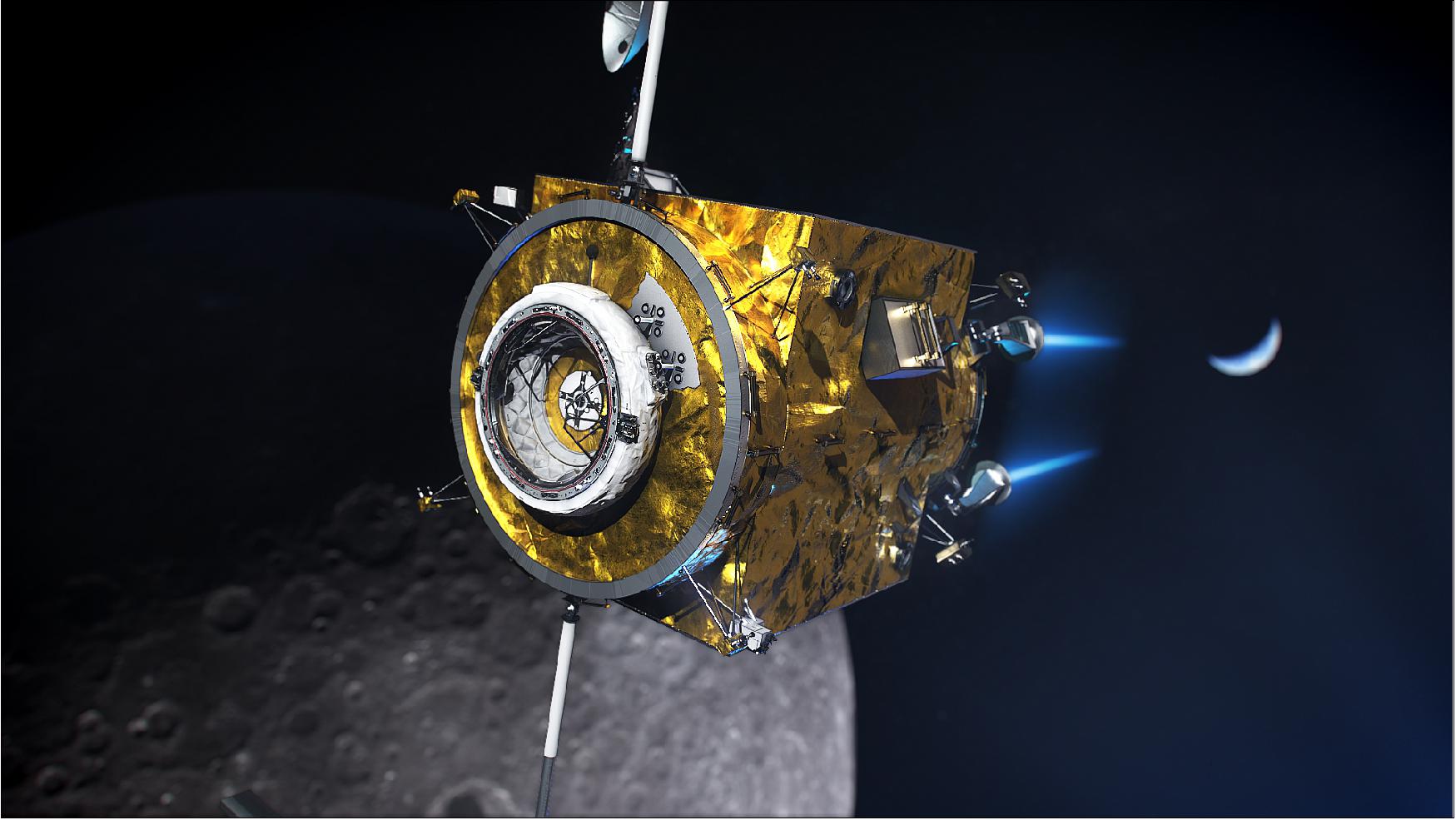
• May 13, 2019: NASA is sending astronauts to the Moon and then on to Mars, in a measured, sustainable way. The direction from Space Policy Directive-1 builds on the hard work NASA is doing on its Space Launch System rocket and Orion spacecraft, agency efforts to enable commercial partners, its work with international partners at the International Space Station in low-Earth orbit, and what NASA learns from its current robotic missions at the Moon and Mars. 29)
- According to NASA, the manned Moon landing mission in 2024 will be named Artemis. 30) 31)
• April 9, 2019: The president directed NASA to land American astronauts on the Moon by 2024, and the agency is working to accelerate humanity's return to the lunar surface by all means necessary. 32)
- "We've been given an ambitious and exciting goal. History has proven when we're given a task by the president, along with the resources and the tools, we can deliver," said NASA Administrator Jim Bridenstine. "We are committed to making this happen. We have the people to achieve it. Now, we just need bipartisan support and the resources to get this done."
- Bridenstine confirmed at the 35th Space Symposium on April 9, 2019, that the agency's proposed human lunar landing system architecture remains the plan to return crew to the surface as quickly as possible. The human lunar lander will be a public-private partnership working directly with American companies to expedite the return of Astronauts to the Moon's surface by 2024. The South Pole continues to be the target of our exploration.
- In order to best accomplish our goals in the next five years, NASA is now going forward to the Moon in two phases.
- "First, we are focused on speed to land the next man, and first woman, on the Moon by 2024. Second, we will establish sustainable missions by 2028. To do that, we need our powerful Space Launch System to put the mass of reusable systems into deep space," he said.
• March 11, 2019: The International Space Station partners have endorsed plans to continue the development of the Gateway, an outpost around the Moon that will act as a base to support both robots and astronauts exploring the lunar surface. 33)
- The MCB (Multilateral Coordination Board), which oversees the management of the Space Station, stressed its common hope for the Gateway to open up a cost-effective and sustainable path to the Moon and beyond. The announcement comes after several years of extensive study among space agencies who have developed a technically achievable design. The partnership includes European countries (represented by ESA), the United States (NASA), Russia (Roscosmos), Canada (CSA) and Japan (JAXA).
- "We are getting ready, together, to send humans farther into the Solar System than ever before. The lunar Gateway is the next big step in human exploration and we are working to make Europe a part of it," says David Parker, ESA's human and robotic exploration director.
- NASA's Orion spacecraft will transport astronauts to the Gateway. Orion is powered by the European Service Module, which will give the crewed vehicle a final push to inject it into translunar orbit.
- Almost 50 years after the first human landing on the Moon, the Gateway will support human and robotic access to the lunar surface. "We will extend the presence of humans one thousand times farther into space compared to today's International Space Station," adds David Parker.
- The Gateway will offer a platform for scientific discovery in deep space and build invaluable experience for the challenges of future human missions to Mars.
- Nearly 400,000 km away from Earth, the Moon's orbit will provide excellent visibility of both the Earth and the Moon's surface allowing it to relay communications.
- According to the board, the Gateway "will stimulate the development of advanced technologies, expand the emerging space economy, and continue to leverage the societal benefits of space exploration for citizens on Earth."
- Canada has already confirmed its commitment to join NASA in the Gateway and contribute advanced robotics to the project, making the Canadian Space Agency the first partner agency.
- ESA's potential involvement includes the ESPRIT (European System Providing Refueling Infrastructure and Telecommunications) module to provide communications and refueling of the Gateway and a science airlock for deploying science payloads and CubeSats.
• March 5, 2019: The ISS Multilateral Coordination Board (MCB), which oversees the management of the ISS, met on March 5th, 2019. Its members (NASA, CSA, ESA, the Government of Japan's Ministry for Education, Culture, Sports, Science and Technology, and the State Space Corporation Roscosmos of Russia) acknowledged the recent 20th anniversary of the launch of the first International Space Station module and celebrated the success of the ISS partnership. This international team has not only built the space station and risen to the challenges of its day-to-day dynamic operation, but – most importantly – delivered tangible benefits to humanity. 34)
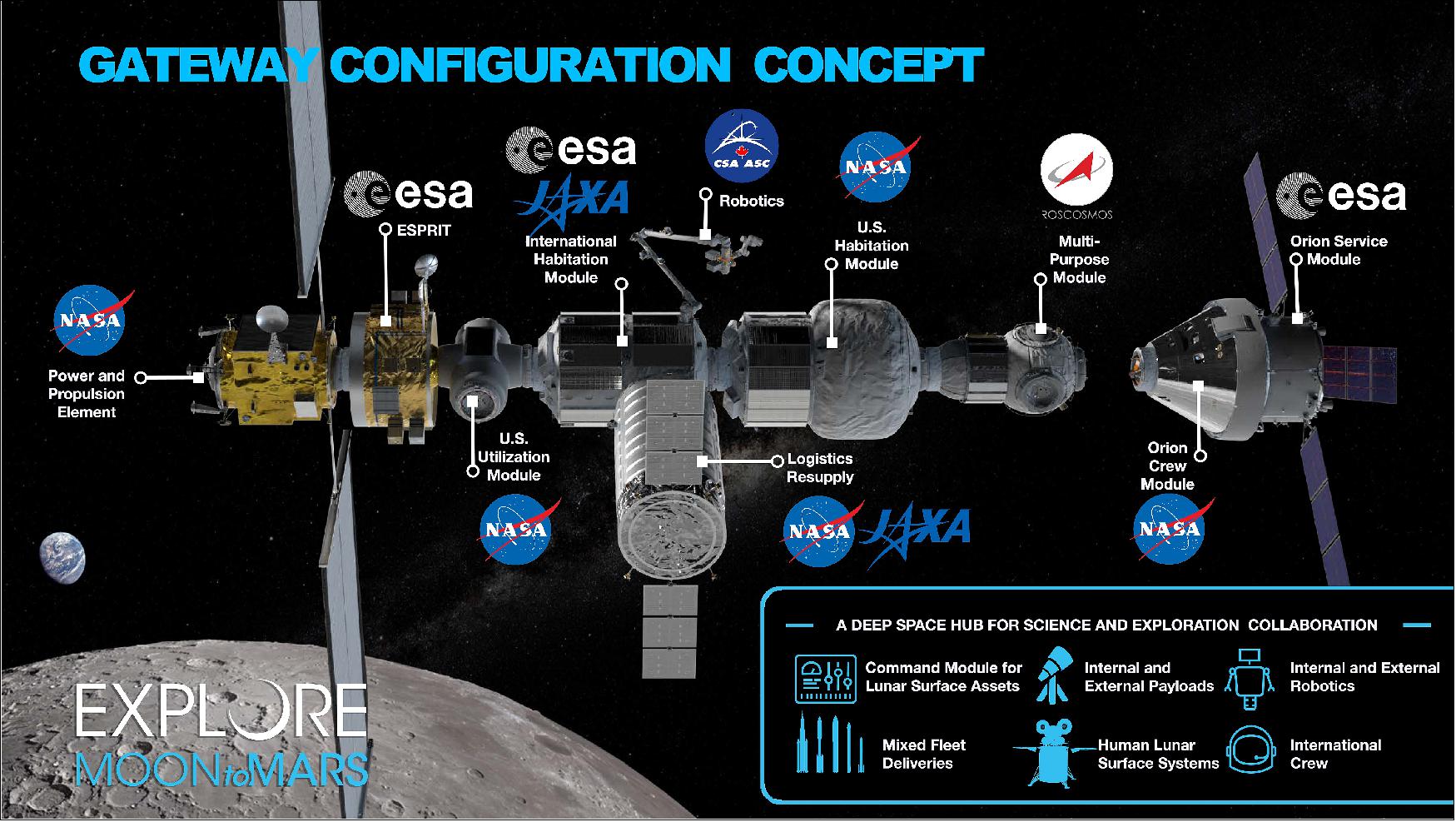
- Important outcomes of the ISS include both new scientific knowledge and technical innovation. These advancements address sustainable development here on Earth and help preparations to extend human presence further into our Solar System. The MCB highlighted the fact that more than 100 countries have now used the space station for research or education. Furthermore, representatives noted with satisfaction that the ISS is nurturing a growing economy in Low Earth Orbit research, business and services.
- Looking beyond the ISS, the MCB recalled the historic achievement almost fifty years ago of the first human landing on the Moon. It reviewed the extensive work carried out by the ISS partners to study concepts for extending human exploration to the Moon and subsequently to Mars. Emphasizing the importance of affordable and sustainable exploration, the MCB discussed their common interest in deploying a human outpost in the lunar vicinity as the next step. Known as the Gateway, it will serve as a way station one thousand times more distant from Earth than today's ISS, to support exploration of the lunar surface.
- Within a broader open architecture for human lunar exploration, the MCB acknowledged the Gateway as a critical next step. The Gateway will support human and robotic access to the lunar surface, and build invaluable experience needed for the challenges of later human missions to Mars. The unique location of the Gateway will offer a platform for important scientific discovery in a deep space environment very different from that of the ISS and enable lunar surface exploration. Its special orbit will also provide excellent visibility of both the Earth and the Moon's surface for communications relay purposes. It will stimulate the development of advanced technologies, expand the emerging space economy, and continue to leverage the societal benefits of space exploration for citizens on Earth. Gateway will ultimately enable international and commercial partners to participate in human exploration, research and technology development and will be foundational for establishing a sustained human presence around and on the Moon.
- Following several years of extensive study among the agencies culminating in a successful technical assessment, the MCB endorsed plans to continue the Gateway development. It welcomed each agency's intention to proceed toward their respective stakeholders' approval and funding processes for providing specific elements, modules, and capabilities to the Gateway and associated benefits based on a common concept (Figure 24).
- The MCB welcomed with enthusiasm Canada's announcement on February 28th, 2019, that it would participate in the Gateway and contribute advanced robotics, making the Canadian Space Agency the first partner agency to join NASA in the Gateway.
- Finally, recalling the ambition and far-sighted decisions that led to the success of both Apollo and the ISS, MCB members affirmed their common hope that the Gateway should secure new achievements in the field of space exploration, serve as the next step on a sustainable path to the Moon and beyond, and inspire the next generation as a future success of international cooperation in science and technology.
ESA Participation in NASA's Lunar Gateway Venture
ESA (European Space Agency) and its Member States have laid out plans as to where the organization sees itself heading in the next few years and a stake in the Lunar gateway is high on its list of priorities. 35)
Using its E3P (European Exploration Envelope Program) as a springboard for ideas, the ESA Council has highlighted the agency's desire for Europe to play a leading role in the global exploration of space and to achieve this, the council have identified three main areas in which to make an impact.
These include; negotiating agreements covering the elements of potential ESA contributions to the Lunar gateway, including both transportation and infrastructure; negotiating agreement(s) covering potential European contributions to an international Mars Sample Return mission or other sample return missions; and examining scenarios and mission concepts for lunar exploration missions supporting the objectives of the European scientific community.
The Participating States in the E3P Program have already begun preparations that could see Europe become a major player in the ‘Lunar gateway' with a reform of a current legal act and with the commissioning of modules to be used as part of the gateway itself.
The Lunar gateway set out as a sole NASA initiative but has since agreed a partnership with Russia to build the first lunar space station. Placed farther from Earth than the current Space Station – but ironically not in a lunar orbit – the gateway will offer a staging post for missions to the Moon and Mars.
ESA is also busy building a European Service Module for NASA's Orion spacecraft - another project designed to take humans deeper into space. Orion – named after one of the largest constellations in the night sky – will serve as the exploration vehicle that will carry crew to space, sustain astronauts during their missions, provide emergency abort capability and provide safe re-entry from deep space return velocities.
ESA's Director of Human and Robotic Exploration David Parker says, "there's no doubt that the next decade is going to be exciting for space exploration. ESA and its Member States are working hard to keep Europe at the heart of the journey of discovery and fascination that lies ahead."
• September 20, 2018: ESA has commissioned Airbus for two studies for possible European involvement in the future human base in lunar orbit. The Gateway, previously known as the Deep Space Gateway (DSG) or Lunar Orbital Platform-Gateway (LOP-G), is a project involving the US, Russian, Canadian, Japanese and European space agencies (NASA, Roscosmos, CSA, JAXA and ESA). 36)
Over the next 15 months, Airbus will develop a concept for a habitation and research module as part of the first study (habitat, approximately 6.5 x 4.5 m and weighing some 9 tons). In the second study, Airbus will design a concept for an infrastructure element for refuelling, docking and telecommunications, which will also serve as an airlock for scientific equipment (known as Esprit, around 3 x 3 m and weighing around 4 tons). Both studies will be developed as part of a far-reaching European partnership.
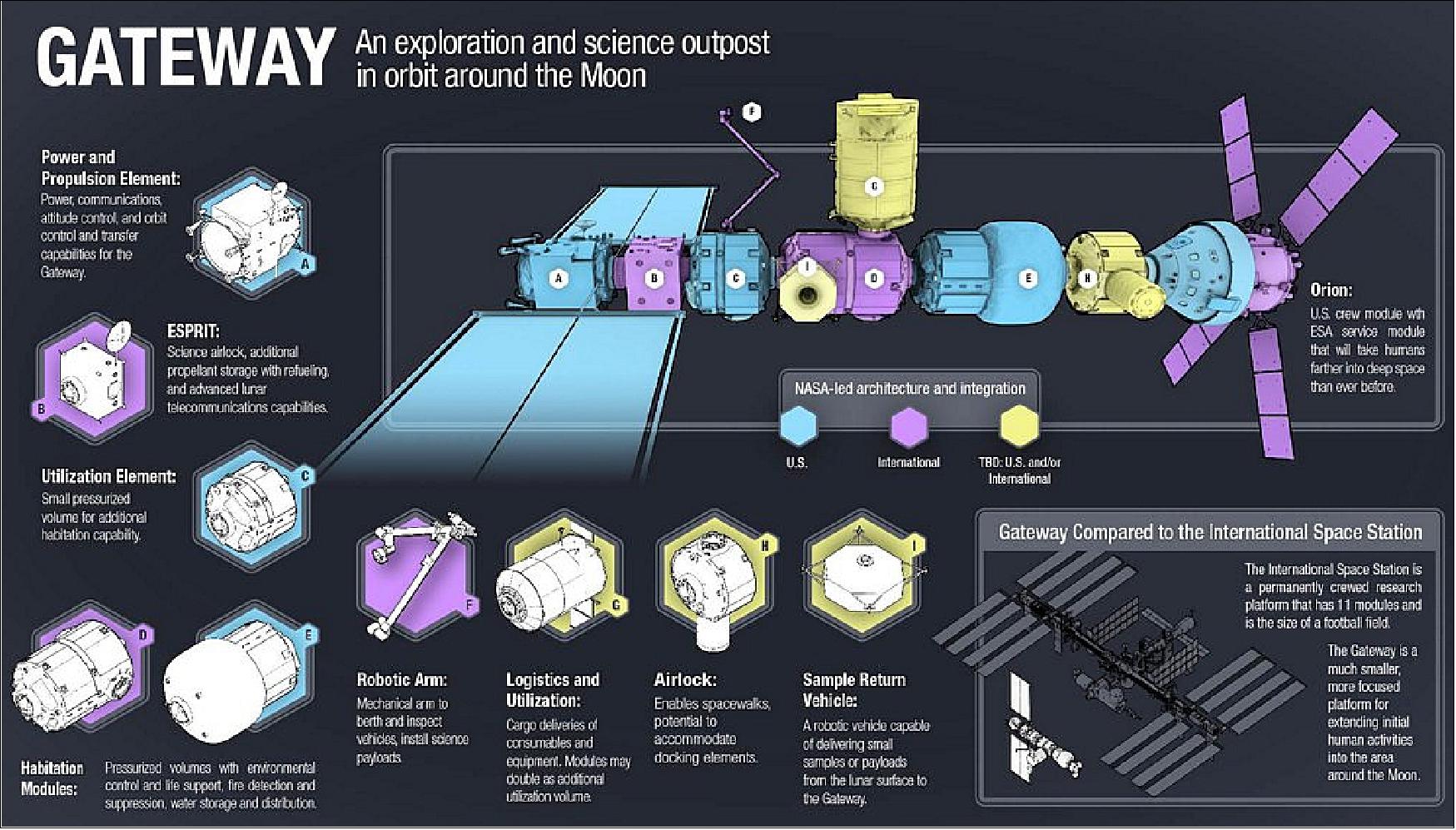
Under NASA's overall design leadership, other elements – such as a second habitat, an airlock for scientific payloads and a logistics module - will be designed by international and commercial partners. NASA has plans to launch the first module - the central PPE (Power Propulsion Element) – into lunar orbit in the early 2020's.
"The experience and know-how that ESA and Airbus have gained during flagship projects such as the Columbus space laboratory, the ATV space transporter and the European service module for Orion provide solid foundations for the studies," said Oliver Juckenhöfel, Head of On-Orbit Services and Exploration at Airbus. "When developing the new lunar platforms, robotic and human space exploration go hand in hand. Europe has a fantastic track record in both, and these two studies will help to ensure a strong European presence in future space exploration."
David Parker, Director of Human and Robotic Exploration at ESA, said: "With these studies and other preparations, ESA aims to stay at the center of human space exploration. The Gateway will become humanity's most remote research outpost and we hope Europe will benefit from the world of innovation, discovery and excitement that lies ahead."
Unlike the International Space Station (ISS), the Gateway is not intended to be continually inhabited. It is envisaged that the lunar platform will act as a staging point for human missions to the Moon or Mars, and testing is planned for a series of technologies and procedures that will be needed.
References
1) "NASA's Lunar Outpost will Extend Human Presence in Deep Space," NASA, 2 May 2018, URL: https://www.nasa.gov/feature/nasa-s-lunar-outpost-will-extend-human-presence-in-deep-space
2) "Gateway Memorandum for the Record," NASA, 2 May 2018, URL: https://www.nasa.gov/sites/default/files/atoms/files/gateway_domestic_and_international_benefits-memo.pdf
3) "NASA Seeks Ideas for Commercial Uses of Gateway," NASA, 19 June 2018, URL: https://www.nasa.gov/feature/nasa-seeks-ideas-for-commercial-uses-of-gateway
4) "Nº 30–2022: From the Earth to the Moon and on to Mars – ESA and NASA take decisions and plan for the future," ESA Press Release, 15 June 2022, URL: https://www.esa.int/Newsroom/Press_Releases/From_the_Earth_to_the_Moon_and_on_to_Mars_ESA_and_NASA_take_decisions_and_plan_for_the_future
5) Jackie McGuinness, Sean Potter, "NASA, ESA Finalize Agreements on Climate, Artemis Cooperation," NASA Press Release 22-060, 15 June 2022, URL: https://www.nasa.gov/press-release/nasa-esa-finalize-agreements-on-climate-artemis-cooperation
6) "Getting ready for lunar orbit," ESA Science & Exploration, 18 February 2022, URL: https://www.esa.int/ESA_Multimedia/Images/2022/02/Getting_ready_for_lunar_orbit
7) "Airbus to develop the Power Management and Distribution System for key Lunar Gateway module," Airbus Press Release, 11 January 2022, URL: https://www.airbus.com/en/newsroom/press-releases/2022-01-airbus-to-develop-the-power-management-and-distribution-system-for
8) Brian Dunbar, "Gateway," NASA, 21 December 2021, URL: https://www.nasa.gov/gateway/overview
9) Jeff Foust, "House appropriators approve NASA spending bill with revised lunar lander and nuclear propulsion language," SpaceNews, 16 July 2021, URL: https://spacenews.com/house-appropriators-approve-nasa-spending-bill-with-revised-lunar-lander-and-nuclear-propulsion-language/
10) "Maxar Completes Power and Propulsion Element Preliminary Design Review," Maxar Press Release, 12 July 2021, URL: https://www.maxar.com/press-releases/maxar-completes-power-and-propulsion-element-preliminary-design-review
11) Monica Witt / Kathryn Hambleton, Isidro Reyna, "NASA, Northrop Grumman Finalize Moon Outpost Living Quarters Contract," NASA Press Release 21-092, 9 July 2021, URL: https://www.nasa.gov/press-release/nasa-northrop-grumman-finalize-moon-outpost-living-quarters-contract
12) "NASA, Government of Japan Formalize Gateway Partnership for Artemis Program," NASA Press Release 21-003, 13 January 2021, URL: https://www.nasa.gov/press-release/nasa-government-of-japan-formalize-gateway-partnership-for-artemis-program
13) "European Gateway module to be built in France as Thomas Pesquet readies for second spaceflight," ESA Science & Exploration, 7 January 2020, URL: https://www.esa.int/Science_Exploration/Human_and_Robotic_Exploration/European_Gateway_module_to_be_built_in_France_as_Thomas_Pesquet_readies_for_second_spaceflight
14) Monica Witt, "NASA, Canadian Space Agency Formalize Gateway Partnership for Artemis Program," NASA Press Release 20-132, 16 December 2020, URL: https://www.nasa.gov/press-release/nasa-canadian-space-agency-formalize-gateway-partnership-for-artemis-program
15) "Positive signs for Europe as ESA goes forward to the Moon," ESA Science & Exploration, 27 October 2020, URL: https://www.esa.int/Science_Exploration/Human_and_Robotic_Exploration/Positive_signs_for_Europe_as_ESA_goes_forward_to_the_Moon
16) "Thales Alenia Space on its way to reach the Moon," Thalesgroup, 14 October 2020, URL: https://www.thalesgroup.com/en/worldwide/space/press-release/thales-alenia-space-its-way-reach-moon
17) Jeff Foust, "ESA awards contracts for moon and Mars exploration," SpaceNews, 15 October 2020, URL: https://spacenews.com/esa-awards-contracts-for-moon-and-mars-exploration/
18) "NASA awards Artemis contract for Gateway Logistics Services," Moon Daily, 30 March 2020, URL: https://www.moondaily.com/reports/NASA_awards_Artemis_contract_for_Gateway_Logistics_Services_999.html
19) Jeff Foust, "SpaceX wins NASA commercial cargo contract for lunar Gateway," SpaceNews, 27 March 2020, URL: https://spacenews.com/spacex-wins-nasa-commercial-cargo-contract-for-lunar-gateway/
20) "European Gateway experiment will monitor radiation in deep space," ESA / Science & Exploration / Human and Robotic Exploration, 13 March 2020, URL: http://www.esa.int/Science_Exploration/Human_and_Robotic_Exploration/European_Gateway_experiment_will_monitor_radiation_in_deep_space
21) "Lunar Gateway: Earth's guard post against asteroids?," ESA / Enabling & Support / Space Engineering & Technology, 9 March 2020, URL: http://www.esa.int/Enabling_Support/Space_Engineering_Technology/Lunar_Gateway_Earth_s_guard_post_against_asteroids
22) "RUAG Space and TTTech Provide Electronics for TTEthernet for NASA's Lunar Gateway," Satnews Daily, 1 November 2019, URL: http://www.satnews.com/story.php?number=1566652470
23) "Moon exploration news," CSA, 19 August 2019, URL: http://www.asc-csa.gc.ca/eng/astronomy/moon-exploration/news.asp
24) "Angelic halo orbit chosen for humankind's first lunar outpost," ESA, 18 July 2019, URL: http://m.esa.int/Our_Activities/Operations/Angelic_halo_orbit_chosen_for_humankind_s_first_lunar_outpost
25) "NASA to Partner with American Industry to Supply Artemis Moon Missions," NASA, 14 June 2019, URL: https://www.nasa.gov/feature/nasa-to-partner-with-american-industry-to-supply-artemis-moon-missions
26) "Artemis Moon Program Advances – The Story So Far," NASA, 31 May 2019, URL: https://www.nasa.gov/artemis-moon-program-advances
27) "FORWARD TO THE MOON:NASA's Strategic Plan for Lunar Exploration," Updated 6 June 2019, URL: https://www.nasa.gov/sites/default/files/atoms/files/america_to_the_moon_2024_artemis_20190523.pdf
28) "NASA Awards Artemis Contract for Lunar Gateway Power, Propulsion," NASA Release 19-042, 23 May 2019, URL: https://www.nasa.gov/press-release/nasa-awards-artemis-contract-for-lunar-gateway-power-propulsion
29) "NASA Highlights Moon 2024 Mission with FY 2020 Budget Amendment," NASA Release 19-039, 13 May 2019, URL: https://www.youtube.com/embed/5Vgzz2_2-84?rel=0
30) Thomas Burghardt, "NASA aims for quick start to 2024 Moon landing via newly named Artemis Program," NASA Spaceflight.com, 14 May 2019, URL: https://www.nasaspaceflight.com/2019/05/nasa-quick-start-artemis-program/
31) https://www.nasa.gov/specials/moon2mars/
32) "Sending American Astronauts to Moon in 2024: NASA Accepts Challenge," NASA, 9 April 2019, URL: https://www.nasa.gov/feature/sending-american-astronauts-to-moon-in-2024-nasa-accepts-challenge
33) "Gateway to the Moon," ESA, 11 March 2019, URL: https://m.esa.int/Our_Activities/Human_and_Robotic_Exploration/Gateway_to_the_Moon
34) "Multilateral Coordination Board Joint Statement," NASA, 5 March 2019, URL: https://www.nasa.gov/feature/multilateral-coordination-board-joint-statement
35) "ESA Council backs Lunar gateway venture," EU, 18 June 2018, URL: https://room.eu.com/news/esa-council-backs-lunar-gateway-venture
36) "Forward to the Moon: Airbus wins ESA studies for future human base in lunar orbit ," Airbus, 20 September 2018, URL: https://web.archive.org/web/20210926123048/https://www.airbus.com/newsroom/press-releases/en/2018/09/Forward-to-the-Moon-Airbus-wins-ESA-studies-for-future-human-base-in-lunar-orbit.html
The information compiled and edited in this article was provided by Herbert J. Kramer from his documentation of: "Observation of the Earth and Its Environment: Survey of Missions and Sensors" (Springer Verlag) as well as many other sources after the publication of the 4th edition in 2002. - Comments and corrections to this article are always welcome for further updates (eoportal@symbios.space).